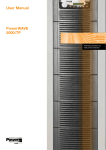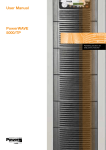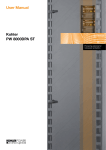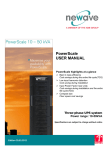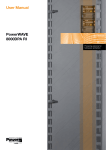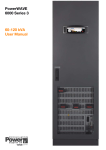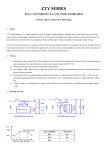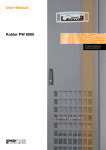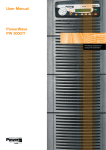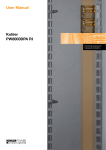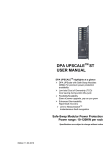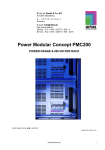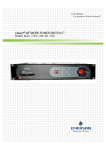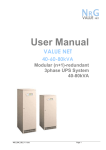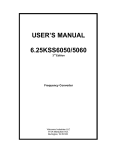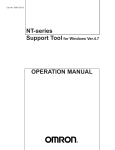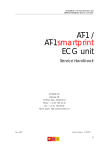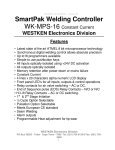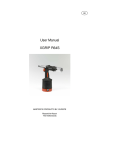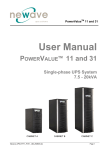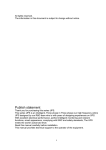Download Kohler PW 5000/TP User Manual - Kohler | Uninterruptible Power
Transcript
User Manual Kohler PW 5000/TP Pioneering solutions for total power protection Document Control ISSUE DATE REVISION SUMMARY 1.0 06-07-11 Initial issue 1.1 14-09-11 Major changes to Chapter 3 plus other general book-wide updates 1.2 31-10-11 General corrections and layout update prior to initial issue. 1.3 17-11-11 Update model nomenclature and general typographical error corrections UPS412-01-01 Kohler PW 5000/TP User Manual Dated 17-11-11 Kohler Uninterruptible Power has taken every precaution to produce an accurate, complete and easy to understand manual and will therefore assume no responsibility nor liability for direct, indirect or accidental personal or material damage due to any misinterpretation of or accidental mistakes in this manual. © 2011 Kohler Uninterruptible Power This manual may not be copied nor reproduced without written permission of Kohler Uninterruptible Power. UPS412-01-01 Kohler PW 5000/TP User Manual Dated 17-11-11 Table of Contents 1 Safety 1.1 Description of symbols used in this manual 1.2 User precautions 2 Description 2.1 Reliability and Quality Standards 2.2 Kohler PW 5000/TP Model Range 2.2.1 Single/Multi-cabinet configurations 2.3 Advanced Design Features 2.3.1 Input booster technology 2.3.2 Flexible battery management 2.3.3 Decentralized Parallel Architecture (DPA) 2.4 Warranty 2.5 Extended Warranty 2.6 Additional Service/Maintenance Support 3 1-1 1-1 2-1 2-1 2-2 2-2 2-2 2-2 2-2 2-2 2-3 2-3 Installation 3.1 Introduction 3.2 Receipt of the UPS 3.2.1 Site transportation 3.2.2 Unpacking the UPS 3.2.3 Batteries 3.3 Storage 3.3.1 UPS storage 3.3.2 Battery 3.4 Positioning 3.4.1 Planning the installation 3.5 UPS Power Cabling 3.5.1 General requirements (preparation and planning) 3.6 Connecting the UPS input supply 3.6.1 Safety notes 3.6.2 Preparation for the input cabling 3.6.3 Connecting the UPS input power cables 3.7 Connecting the UPS output 3.7.1 Safety notes 3.7.2 Preparation for the output cabling 3.7.3 Connecting the UPS output cables 3.8 Battery connections 3.8.1 Remote battery enclosures 3.8.2 Connecting the external battery enclosure 3.9 Multi-module control cabling and configuration 3.9.1 Connecting the parallel communication cables (Bus-lines) 3.9.2 Configuration DIP Switch selection UPS412-01-01 Kohler PW 5000/TP User Manual Dated 17-11-11 3-1 3-1 3-1 3-2 3-2 3-3 3-3 3-3 3-3 3-3 3-5 3-5 3-13 3-13 3-13 3-13 3-14 3-14 3-14 3-15 3-19 3-19 3-19 3-21 3-21 3-22 I 3.10 Module interfacing facilities 3.10.1 JD1 Smart Port – Serial RS 232 and USB Port 3.10.2 X1 Dry Port (volt-free contacts) 3.10.3 JR1 / RS485 INTERFACE FOR MULTIDROP 3.10.4 X2 Dry Port – Optional Output Interfaces Terminal Block (X2) 4 Operation 4.1 Commissioning 4.2 Control Panel 4.2.1 Power Management Display (PMD) 4.2.2 Mimic LED indicators 4.2.3 Operator keys 4.3 Description of the LCD display 4.3.1 Status screens 4.3.2 Main menu screen 4.3.3 Event log menu screen 4.3.4 Measurements menu screen 4.3.5 Commands menu screen 4.3.6 UPS Data menu screen 4.3.7 Set-up User menu screen 4.3.8 Set-Up Service menu screen 4.4 Operating Modes 4.4.1 On-Line (Inverter) mode 4.4.2 Bypass (Line-Interactive) mode 4.4.3 Maintenance Bypass Mode 4.4.4 Multi-module configuration concept 4.5 Operating Instructions 4.5.1 Transfer to Maintenance Bypass Mode 4.5.2 Starting the UPS system from the Maintenance Bypass 4.5.3 Complete system shutdown 4.5.4 Individual module start/stop procedure 5 Introduction System calibration User responsibilities Routine maintenance Battery Testing 5-1 5-1 5-1 5-1 5-2 Troubleshooting 6.1 Alarms 6.2 Menu, Commands, Event Log, Measurements, 6.2.1 Event Log Screen 6.2.2 Fault Identification and Rectification Messages and Alarms 6.3 Contacting Service II 4-1 4-1 4-1 4-2 4-2 4-3 4-3 4-4 4-4 4-4 4-5 4-5 4-6 4-6 4-7 4-7 4-7 4-8 4-9 4-10 4-10 4-12 4-14 4-15 Maintenance 5.1 5.2 5.3 5.4 5.5 6 3-22 3-23 3-24 3-24 3-24 6-1 6-1 6-1 6-2 6-2 UPS412-01-01 Kohler PW 5000/TP User Manual Dated 17-11-11 7 Options 7.1 7.2 7.3 7.4 7.5 Introduction Remote Emergency Stop facilities Generator ON facilities Temperature sensor for temperature-dependant battery charging WAVEMON Shutdown and Management Software 7.5.1 Why is UPS Management important? 7.5.2 WAVEMON Shutdown and Monitoring Software 7.6 SNMP CARD/ADAPTOR For Network Management/Remote Monitoring 7.7 Modem/Ethernet card / PowerREPORTER™ management software 8 7-1 7-1 7-2 7-3 7-4 7-4 7-4 7-5 7-7 Specifications 8.1 8.2 8.3 8.4 8.5 8.6 8.7 8.8 8.9 Mechanical Input Characteristics Output Characteristics Battery Characteristics Environmental Heat Dissipation With Non-Linear Loads Standards Communication Options Fuses & Cables Quick Reference UPS412-01-01 Kohler PW 5000/TP User Manual Dated 17-11-11 8-1 8-2 8-2 8-3 8-3 8-3 8-4 8-4 8-5 III IV UPS412-01-01 Kohler PW 5000/TP User Manual Dated 17-11-11 1 1.1 Safety Description of symbols used in this manual WARNING: The warning symbol is used where there is danger of an electrical shock, equipment damage or personal-injury. CAUTION: The caution symbol is used to highlight important information to avoid possible equipment malfunction or damage. 1.2 User precautions WARNING: Keep this manual with the UPS for future reference. WARNING: The UPS and peripheral equipment must be installed and commissioned by suitably qualified and trained personnel who are aware of the potential shock hazards. WARNING: Do not attempt to install this UPS system until you are satisfied that ALL the safety instructions and hazard warnings contained in this manual are read and fully understood. WARNING: High leakage current! Ensure that the UPS has been correctly earthed before you connect the mains power supply! WARNING: This UPS must not be started-up or put into use without having first been commissioned by a fully trained engineer authorised by the manufacturer. WARNING: All servicing must be performed by qualified personnel. Do not attempt to service the UPS yourself. You run risk of exposure to dangerous voltages by opening or removing the UPS-covers! Kohler Uninterruptible Power will assume no responsibility nor liability due to incorrect operation or manipulation of the UPS. WARNING: The Kohler PW 5000/TP is a Class A UPS product. In a domestic environment the UPS may cause radio interference. In such an environment the user may be required to undertake additional measures. UPS412-01-01 Kohler PW 5000/TP User Manual Dated 17-11-11 1-1 1: Safety 1-2 UPS412-01-01 Kohler PW 5000/TP User Manual Dated 17-11-11 2 2.1 Description Reliability and Quality Standards Congratulations on your purchase of the Kohler PW 5000/TP UPS. The Kohler PW 5000/TP UPS represents a completely new generation of mid-range, 3 phase UPS-Systems, incorporating the latest technological developments in power engineering. It is an advanced double conversion UPS, VFI (Voltage and Frequency Independent) topology that responds fully to both highest availability and environmentally friendly requirements compliant with IEC 62040-3 (VFI-SS-111) standards. High reliability, upgrade ability, low operating costs and excellent electrical performance are only some of the highlights of this innovative UPS solution. Kohler Uninterruptible Power specialises in the design, building, installation and maintenance of Uninterruptible Power Systems. This compact and powerful UPS is just one example of our wide range of state-of-the-art power protection devices and will provide your critical equipment with a steady and reliable power supply for many years. The criteria and methods which are used in the design, manufacture, and maintenance of Uninterruptible Power Supply systems are certified to International Standard ISO 9001/EN 29001 and ISO 14001. A full UPS Specification is given in Chapter 8 of this manual. 2.2 Kohler PW 5000/TP Model Range The Kohler PW 5000/TP UPS range covers 10, 15, 20, 25, 30, 40 and 50kVA models, in three different sized cabinets, that can be employed in a Single or Multi-Module configuration. Cabinet A Cabinet B Cabinet C 10kVA, 15kVA, 20kVA (WxHxD = 345x720x710) 10kVA, 15kVA, 20kVA, 25kVA (WxHxD = 345x1045x710) 25kVA, 30kVA, 40kVA, 50kVA (WxHxD = 440x1420x910) Figure 2.1 Kohler PW 5000/TP Cabinet details UPS412-01-01 Kohler PW 5000/TP User Manual Dated 17-11-11 2-1 2: Description 2.2.1 Single/Multi-cabinet configurations The Kohler PW 5000/TP UPS may be configured to operate as a single cabinet, or several (up to 20) cabinets can be connected in parallel to operate as a multi-module UPS system. A multi-module configuration is generally used either to increase the system’s total power capacity, or to provide module redundancy. This manual describes the installation, configuration and operation of both single and multimodule systems. Note: Although the UPS single/multi configuration can be modified in the field it is generally specified on ordering so that the module can be configured and fully tested in the factory prior to despatch. 2.3 Advanced Design Features 2.3.1 Input booster technology The UPS module’s inbuilt advanced booster technology results in a perfect sinusoidal input power quality at 0.99 input power factor with a harmonic content of 3% THD(i). This leads to a more reliable total system operation and savings in generator and transformer sizing, as losses in the windings are minimised. It also means that traditional harmonic filters are no longer required. The high power factor presented by the UPS on the incoming mains supply minimises cabling and fusing costs due to the resulting lack of reactive power consumption. This, together with the accompanying low harmonic currents, provide the following benefits: • • • • • • No additional losses in wires and cables. No extra heating of transformers and generators. No over sizing of generators. No false circuit breaker tripping and malfunction. No erratic operation of computers, telecommunication, monitors, electronic test equipment etc. No resonance with power factor correction capacitors. 2.3.2 Flexible battery management This equipment employs a flexible battery management which avoids premature deterioration of battery life by advanced management of battery charging and preventive failure diagnostics. The major benefits are: • • • • • • • • AC-ripple free battery charging due to a dc-dc charger separated from the rectifier and inverter. Wide range of number of battery blocks (22-50 blocks of 12V; depending on autonomy times). UPS's wide input voltage operating window extends the battery life due to fewer discharge cycles. Battery discharge protection caused by load jumps. Proactive battery protection from false manipulations and inadequate charging voltages. Proactive battery failure detection thanks to Advanced Battery Diagnosis (ABD) - Algorithm. User selectable battery tests. Optional temperature compensated charging to enhance battery life. 2.3.3 Decentralized Parallel Architecture (DPA) The Kohler PW 5000/TP system features DPA paralleling technology that provides n+x redundancy without introducing a single-point-of-failure. The modules utilizing the DPA technology are completely autonomous by means of individual power units, bypasses, CPUs, control panels and separate battery configuration. 2.4 Warranty The Kohler PW 5000/TP UPS is supplied with a limited warranty that the UPS and its component parts are free from defects in materials and workmanship for a period of one year from the date of original commissioning or fifteen months from the date of original delivery, whichever is the sooner. This warranty is the only warranty given and no other warranty, express or implied, is provided. This warranty is invalidated if the UPS is put into use without having been commissioned by a fully trained and authorised person. This warranty does not apply to any losses or damages caused by misuse, abuse, 2-2 UPS412-01-01 Kohler PW 5000/TP User Manual Dated 17-11-11 2: Description negligence, neglect, unauthorised repair or modification, incorrect installation, inappropriate environment, accident, act of God or inappropriate application. If the UPS fails to conform to the above within the warranty period then Kohler Uninterruptible Power. will, at its sole option, repair or replace the UPS. All repaired or replaced parts will remain the property of Kohler Uninterruptible Power. As a general policy, Kohler Uninterruptible Power does not recommend the use of any of its products in life support applications where failure or malfunction of the product can be reasonably expected to cause failure of the life support device or to significantly affect it’s safety or effectiveness. Kohler Uninterruptible Power does not recommend the use of any of its products in direct patient care. Kohler Uninterruptible Power will not knowingly sell its products for use in such applications unless it receives in writing assurances satisfactory to Kohler Uninterruptible Power that the risks of injury or damage have been minimized, the customer assumes all such risks and the liability of Kohler Uninterruptible Power is adequately protected under the circumstances CAUTION: The UPS may contain batteries which must be re-charged for a minimum of 24 hours every six months to prevent deep-discharging. Batteries that have been, for whatever reason, deep-discharged are not covered by the warranty. 2.5 Extended Warranty The Standard Warranty may be enhanced by protecting the UPS with an Extended Warranty Agreement (maintenance contract). An Extended Warranty Agreement enhances the standard warranty by providing the following: • • • • Regular preventative maintenance inspections. Guaranteed speed of response to operational problems. 24 hour telephone support. Fully comprehensive cover – excluding batteries and capacitors. Contact the Service Support Hotline on +65 6302 0708 for further details. 2.6 Additional Service/Maintenance Support In addition to providing support for the Kohler PW 5000/TP UPS, Kohler Uninterruptible Power are able to provide maintenance and support on a wide range of different UPS products. If you are interested in an extended warranty for your Kohler PW 5000/TP UPS, or any other UPS you may have, please complete the enquiry form shown opposite and return or FAX to: Regional Office (South East Asia) Kohler Uninterruptible Power. 7 Jurong Pier Singapore 619159 Tel: +65 6302 0708 Fax: +65 6302 0717 Email: [email protected] UPS412-01-01 Kohler PW 5000/TP User Manual Dated 17-11-11 2-3 2: Description www.kohlerups.sg Fax to: +65 6302 0717 Regional Office (South East Asia) Kohler Uninterruptible Power 7 Jurong Pier Singapore 619159 Tel: +65 63020708 Name: ............................................................................................ Job Title: ............................................................................................ Company: ............................................................................................ Address: ............................................................................................ ............................................................................................ ............................................................................................ ............................................................................................ Post Code ............................................................................................ Tel. ............................................................................................ Fax. ............................................................................................ E-mail ............................................................................................ Please contact me to discuss: Extended Warranty options for my Kohler PW 5000/TP UPS Extended warranty options for my UPS System as below: Manufacturer:................................................................... Model Nº:.......................................................................... Rating kVA:....................................................................... Replacement Batteries...................................................................... Other ..................................................................(please specify) Thank you for your enquiry, which will receive our prompt attention. If you need to contact us immediately on +65 63020708, or E-mail us on [email protected] 2-4 UPS412-01-01 Kohler PW 5000/TP User Manual Dated 17-11-11 3 3.1 Installation Introduction This chapter contains all the information necessary for the correct unpacking, positioning, cabling and installation of the Kohler PW 5000/TP UPS. WARNING: All the operations described in this section must be performed by authorised electricians or suitably qualified personnel. Kohler Uninterruptible Power will take no responsibility for any personal or material damage caused by incorrect cabling or operations, or activities which are not carried out in strict accordance with the instructions contained in this manual. 3.2 Receipt of the UPS The UPS and accessories are delivered on a specifically designed pallet that is easy to move with a forklift or a pallet jack. CAUTION: When off loading the UPS always keep it in an upright position. Do not drop the equipment. Do not stack the pallets due to the high-energy batteries involved and the heavy weight. The packing container protects the UPS from mechanical and environmental damage. This protection is further increased by wrapping the Kohler PW 5000/TP UPS with a plastic sheet. Upon receiving the UPS, carefully examine the packing container and the UPS for any sign of physical damage. The outside 'Tip&Tel' (“FRAGILE” and “ARROW”) indicator should be intact if the equipment has been transported in an upright position. In case of rupture (or if they are suspect) inform the carrier and Kohler Uninterruptible Power immediately. CAUTION: Visible transport damages must be notified to the carrier immediately after receipt! Other claims for shipping damage must also be filed immediately and the carrier must be informed within 7 days of receipt of the equipment. Packing materials should be stored for further investigation. Ensure that the received UPS corresponds to the description indicated in the delivery note. 3.2.1 Site transportation If you transport the UPS equipment after it has been off-loaded (for example, for storage or moving to a different installation location) please observe the following precautions. CAUTION: Potential dangers: – Do not tilt the UPS or Battery Cabinet by more than 10° as it might damage the equipment. If the equipment has been tilted do not connect it to the mains electricity supply. – The weight of the UPS system could cause serious injuries to personnel or other equipment in the surrounding area. CAUTION: Storage: – The UPS should be stored in the original packing and shipping carton. – The recommended storing temperature for the UPS system and batteries is between +5 °C and +40°C. – The UPS system and the battery sets must be protected from humidity < 90% RH (noncondensing). UPS412-01-01 Kohler PW 5000/TP User Manual Dated 17-11-11 3-1 3: Installation 3.2.2 Unpacking the UPS WARNING: The UPS system, the battery cabinet (option) and the batteries are heavy and may tip during transportation causing serious injury if the unpacking instructions are not followed closely. The smaller cabinets (cabinets A & B) are attached to the shipping pallet, wrapped in polythene and protected by a sturdy cardboard covering. The larger cabinet (cabinet C) is shipped in a wooden case. CAUTION: Before you finally unpack the equipment, remove any additional external shipping packaging and visually check that the ‘Tip&Tel’ indicator (“FRAGILE” and “ARROW”) on the packing container is intact. 1. Ensure that the floor surface is level and suitable for wheeling and taking the heavy weight. 2. Remove cardboard packing container by pulling it upwards. The packaging will contain a wooden ramp. 3. Remove the protective plastic cover and any other packing around the UPS. 4. Remove the fixings securing the UPS to the pallet. 5. Position the enclosed ramp at the rear side of the cabinet and roll the UPS down the ramp. 3 2 4 6) Retain the packaging materials for future shipment of the UPS. 7) Examine the UPS for any sign of damage and notify your carrier or supplier immediately if damage is apparent. Figure 3.1 Unpacking cabinets A & B Checking the nameplate Before proceeding, check that the technical specifications on the nameplate, situated on the rear of the UPS or behind the front internal door, corresponds to the purchased material mentioned in the goods delivery note. 3.2.3 Batteries The batteries connected to the UPS are usually of a sealed, maintenance-free design. The batteries can be mounted either within the UPS, in an external battery cabinet, or on a bespoke battery rack, depending on the required autonomy time and paralleling arrangement. For optimum reliability a separate battery string should be connected to each individual UPS. The batteries are usually shipped separately and fitted by a manufacturer-approved engineer when the UPS is commissioned. If the UPS is delivered without batteries, Kohler Uninterruptible Power is not responsible for any damage or malfunctioning caused to the UPS by the incorrect supply, storage, installation or connection of batteries by third parties. 3-2 UPS412-01-01 Kohler PW 5000/TP User Manual Dated 17-11-11 3: Installation 3.3 Storage 3.3.1 UPS storage If you plan to store the UPS prior to use, it should be kept in a clean, dry environment with an ambient temperature between -25°C to +70°C and relative humidity of less than 90%. If the UPS is removed from the packing container you must also ensure you protect it from dust. 3.3.2 Battery The storage capability of the UPS batteries depends greatly on the ambient temperature. It is important not to store the UPS batteries for longer than 6 months at 20°C, 3 months at 30°C or 2 months at 35°C storage temperature without recharging the battery. For longer term storage the battery must be fully recharged every 6 months @20°C. CAUTION: Sealed batteries must never be stored in a discharged or partially discharged state. Extreme temperature, under-charge, overcharge or over-discharge will destroy the batteries! Key Point: Note the following: • • • 3.4 Charge the battery both before and after storing. Always store the batteries in a dry, clean, cool environment in their original packaging. If the packaging is removed protect the batteries from dust and humidity. Positioning 3.4.1 Planning the installation A certain amount of pre-planning will help ensure smooth, trouble-free equipment installation. The following guidelines should be taken into account when planning a suitable UPS location and environment. 1. The equipment must be installed and transported in a upright position. 2. The floor at the installed location and en-route from the off-loading point must be able to safely take the weight of the UPS and battery equipment plus fork lift during transit. The floor material where the UPS is to be located should be non-flammable. 3. The UPS cabinet requires space to bottom/front and back to enable cooling airflow. Allow a minimum of 200mm clearance at the back of the cabinet. Suitable ventilation airflow (not exceeding +40°C) must be provided (See Figure 3.2). 4. All parts of the UPS requiring access for maintenance, servicing and user operation are accessible from the front and rear. Reserve a minimum of 900mm space at the front of the UPS cabinet. 5. An ambient temperature of 20°C is recommended to achieve a long battery life. 6. Avoid high ambient temperature, moisture and humidity. In summary The UPS should be located where: a) Humidity (< 90% non-condensing) and temperature (+15°C / + 25°C) are within prescribed limits. b) Fire protection standards are respected. c) Cabling can be performed easily. d) A minimum 900mm front accessibility is available for service or periodic maintenance. e) Requested air cooling flow is available. f) The air conditioning system can provide a sufficient amount of air cooling to keep the room at, or below, the maximum desired temperature. g) No dust or corrosive/explosive gases are present. h) The location is vibration free. i) If the UPS is to be installed in bayed enclosures, partition walls have to be installed. UPS412-01-01 Kohler PW 5000/TP User Manual Dated 17-11-11 3-3 3: Installation Y* Y* X V X BATTERY CABINET (option) UPS Front Front Z Z Access Space V 600 mm X Y* Z 600 mm 200 mm 900 mm *Although the diagram shows 200mm is required at the rear of the cabinet, ‘A’ and ‘B’ cabinets should be cabled such that the cabinet can be pulled forward to give access to the rear connections. Figure 3.2 UPS Space Recommendations 10kVA 15kVA 20kVA 25kVA 30kVA 40kVA 50kVA Heat Dissipation with 100% Non-linear Load per range (EN 62040-3) W 600 900 1100 1400 1700 2300 2900 Heat Dissipation with 100% Non-linear Load per range (EN 62040-3) BTU/h 2048 3072 3754 4778 5802 7850 9898 m³/h 150 150 150 150 570 570 570 W 120 150 150 170 250 300 350 Airflow (25°C - 30°C) with 100% Non-linear Load per range (EN 62040-3) Heat Dissipation without load Dimensions (WxHxD)mm Maintenance/Service Accessibility Positioning Input and Output Power Cabling 3-4 Cabinet A Cabinet B Cabinet C Batt Cab C 345x720x710 345x1045x710 440x1420x910 480x1420x940 Top, rear, front, left and right side Top, front, left and right side Min. 200mm rear space required for ventilation From the bottom at the rear. From the bottom at the front UPS412-01-01 Kohler PW 5000/TP User Manual Dated 17-11-11 3: Installation 3.5 UPS Power Cabling 3.5.1 General requirements (preparation and planning) It is the customer’s responsibility to provide all external fuses, isolators and cables used to connect the UPS input and output power supplies. The information in this section should help in the planning and preparation of the UPS power cabling. The UPS input supply and bypass supply should be connected to the utility mains through a LV-Distribution board and protected by a circuit breaker or fuse. This provides overload protection and also a means of isolating the UPS from the mains supply when required. Similarly, the UPS output supply should be connected to the load equipment via a suitably fused output distribution panel. The UPS can be wired with a ‘single feed’ input (standard), whereby the UPS input supply is internally connected to the UPS bypass circuit, or it can be wired with a ‘dual feed’ input – where the UPS bypass circuit is connected to a dedicated ‘bypass’ supply (See Figure 3.4). Figure 3.4 identifies the UPS input/output cabling requirements and provides information regarding the necessary fuse and cable ratings, and cable sizing. Key Point: This information is given for guidance only. All fuses, isolators and power cables must be rated and installed in accordance with the prescribed IEC standards or local regulation. Figures 3.6/ 3.7 show details of the power terminal connections within the UPS including connection sizes and recommended tightening torque. This illustration shows that the UPS unit requires the following power cables: Rectifier (In): • three-phase (1L1, 1L2, 1L3) • neutral (1N) • protective earth (PE) connection for the rectifier input Bypass (In) (Dual feed system only): • three-phase (2L1, 2L2, 2L3) • neutral (2N) • protective earth (PE) connection for the bypass if used as ‘Dual Feed’ input Load (Out): • three-phase (3L1, 3L2, 3L3) • neutral (3N) • protective earth (PE) connection for the load output External Battery: • Plus (+) • Common (N) • Minus (-) • protective earth (PE) connection for the external batteries • the UPS internal batteries must be disconnected if external batteries are used. Under no circumstances should external and internal batteries be connected together in parallel. UPS412-01-01 Kohler PW 5000/TP User Manual Dated 17-11-11 3-5 3: Installation Input neutral grounding Key Point: Input neutral is required to operate the rectifier. In TN-S systems, no 4-pole input switches or circuit breakers should be used. During battery operation the neutral must always be grounded. UPS 0V 230V Figure 3.3 Input neutral grounding 3-6 UPS412-01-01 Kohler PW 5000/TP User Manual Dated 17-11-11 3: Installation SINGLE INPUT FEED (standard) DUAL INPUT FEED Mains (3x380/220V, 3x400/230V, 3x415/240V) Fuse A Cable A Fuse B FA1 FA2 EXTERNAL BATTERY CABINET (option) FA4 Inverter FA3 (F1) Static Switch Output Switch FA2 Rectifier Inverter FA3 (F1) Cable C FA1 Rectifier FA4 Fuse C Cable B IA2 Maint. Bypass IA1 Int. Batts. EXTERNAL BATTERY CABINET (option) Static Switch Output Switch Maint. Bypass IA2 IA1 Int. Batts. Cable D Cable D Load Load SINGLE INPUT FEED Power (kVA) Fuse A (Agl/CB) (A) Cable A (mm²) Cable D (mm²) 10 3 x 20 5 x 2.5 5 x 2.5 15 3 x 32 5 x 4.0 5 x 4.0 20 3 x 40 5 x 6.0 5 x 6.0 25 3 x 40 5 x 6.0 5 x 6.0 30 3 x 63 5 x 10 5 x 10 40 3 x 80 5 x 25 5 x 25 50 3 x 80 5 x 25 5 x 25 DUAL INPUT FEED Power (kVA) Fuse B (Agl/CB) (A) Cable B (mm²) Fuse C (Agl/CB) (A) Cable C (mm²) Cable D (mm²) 10 3 x 20 5 x 2.5 3 x 20 5 x 2.5 5 x 2.5 15 3 x 32 5 x 4.0 3 x 32 5 x 4.0 5 x 4.0 20 3 x 40 5 x 6.0 3 x 40 5 x 6.0 5 x 6.0 25 3 x 40 5 x 6.0 3 x 40 5 x 6.0 5 x 6.0 30 3 x 63 5 x 10 3 x 63 5 x 10 5 x 10 40 3 x 80 5 x 25 3 x 80 5 x 25 5 x 25 50 3 x 80 5 x 25 3 x 80 5 x 25 5 x 25 Notes: 1. Fuse and Cable recommendations to IEC 60950-1:2001 2. The fuse and cable rating details in the above tables are a recommendation only. 3. The UPS must be installed to prescribed IEC or local regulations. 4. External DC Cables and Battery fuses are bespoke to the installation. Figure 3.4 Kohler PW 5000/TP fuse & cable rating UPS412-01-01 Kohler PW 5000/TP User Manual Dated 17-11-11 3-7 3: Installation Cabling a parallel system In order to achieve equal load sharing between the UPS-cabinets in a multi-cabinet installation, the input cables from the input distribution board to each UPS cabinet should be of equal length. Similarly the UPS output cables to the output distribution board should be of equal length (See Figure 3.5). Recommended cable configurations Rectifier Feed UPS 1 UPS 2 Bypass Feed UPS 3 UPS 4 To Load The cable configuration below is not recommended Bypass Feed Rectifier Feed UPS 1 UPS 2 UPS 3 UPS 4 To Load Figure 3.5 Cable lengths for multi cabinet configurations (assuming a dual input supply) 3-8 UPS412-01-01 Kohler PW 5000/TP User Manual Dated 17-11-11 3: Installation To Bypass Line Fuses (FA2) 10kVA – 25kVA (Cabinets A & B) Power Connections (Single input feed) For models in this power range the external power connections are made to a row of terminals located on the UPS Filter Board which is accessible from the rear of the UPS module. Note that the Single Input configuration requires the bypass line fuses to be connected to FA7/FA9/FA11 on the Filter Board. This is the standard configuration set when leaving the factory unless a dual input configuration is specified. FA11 FA7 Ex.Batt. FA9 FA25 FA24 Earth InputMains BypassMains UPSOutput Earth + N PE PE FA23 1L2 1N 3L2 1L1 1L3 3N 3L1 3L3 PE PE To Bypass Line Fuses (FA2) 10kVA – 25kVA (Cabinets A & B) Power Connections (Dual input feed) FA11 This illustration shows the connections for a Dual input configurations, with a separate mains supply connected to the Bypass Mains terminals. Note that the Dual Input configuration requires the bypass line fuses to be connected to FA23/FA24/FA25 on the Filter Board. If necessary these cables will be reconfigured by the Commissioning Engineer as part of the commissioning procedure. FA7 Ex.Batt. FA9 FA25 FA24 Earth InputMains BypassMains UPSOutput Earth + N PE PE FA23 1L2 1N 1L1 1L3 2L2 2N 2L1 2L3 3L2 3L1 3L3 3N PE PE UPS Range Battery (+ / N / -) +PE Input Bypass 3+N (N,2L1,2L2,2L3) Input Rectifier 3+N+PE (N,1L1,1L2,1L3) Output load 3+N+PE (N,3L1,3L2,3L3) Max. cable section admissible Tightening Torque (Nm) 10-25kVA 4 x 16 mm2 4 x 16 mm2 5 x 16 mm2 5 x 16 mm2 16 mm2 1.5 Fuse and Cable recommendations to IEC 60950-1:2001. The fuse and cable rating details in the above tables are a recommendation only. The UPS must be installed to prescribed IEC or local regulations. Figure 3.6 15-25kVA Connection details UPS412-01-01 Kohler PW 5000/TP User Manual Dated 17-11-11 3-9 3: Installation 3 x input/bypass mains links (for single input feed only) Input/bypass neutral always linked 25kVA – 50kVA (Cabinet C) Power Connections (Single input feed) 1L1 1L2 1L3 1N PE PE 3L1 3L3 PE 3N + N 3L2 PE For models in this power range the external power connections are made to a row of terminals blocks mounted on a rail on the front of the UPS module. Note that the Single Input configuration requires three links to be fitted between the input and bypass supply connections, as shown in the above illustration. This is the standard configuration set when leaving the factory unless a dual input configuration is specified. 25kVA – 50kVA (Cabinet C) Power Connections (Dual input feed) 1L1 1L2 1L3 1N PE PE + N 3L1 3L3 PE 2L1 2L2 2L3 2N 3N 3L2 PE The above illustration shows the connections for a Dual input configurations, with a separate mains supply connected to the Bypass Mains terminals. Note that the Dual Input configuration requires the links to be removed between in input and bypass terminals. If necessary these cables will be reconfigured by the Commissioning Engineer as part of the commissioning procedure. UPS Range Battery (+ / N / -) +PE Input Bypass 3+N (N,2L1,2L2,2L3) Input Rectifier 3+N+PE (N,1L1,1L2,1L3) Output load 3+N+PE (N,3L1,3L2,3L3) Max. cable section admissible Tightening Torque (Nm) 30-50kVA 4 x 35 mm2 4 x 35 mm2 5 x 35 mm2 5 x 35 mm2 35 mm2 3.5 Fuse and Cable recommendations to IEC 60950-1:2001. The fuse and cable rating details in the above tables are a recommendation only. The UPS must be installed to prescribed IEC or local regulations. Figure 3.7 30-50kVA Connection details 3-10 UPS412-01-01 Kohler PW 5000/TP User Manual Dated 17-11-11 3: Installation INPUT MAINS SUPPLY L1 L2 L3 N PE A A A A A IL1 IL2 IL3 IN PE1 FA1 Input Fuse Fuse A 2L1 2L2 2L3 2N PE2 Bypass Links FA2 Rectifier FA3 (F1) Battery Fuse Bypass Fuse Maintenance Bypass Switch Inverter IA1 Static Switch Output (Parallel) Switch UPS Cabinet IA2 3L1 3L2 3L3 3N PE3 D D D D D OUTPUT (LOAD) SUPPLY SINGLE INPUT FEED Power (kVA) Fuse A (Agl/CB) (A) Cable A (mm²) Cable D (mm²) 10 3 x 20 5 x 2.5 5 x 2.5 15 3 x 32 5 x 4.0 5 x 4.0 20 3 x 40 5 x 6.0 5 x 6.0 25 3 x 40 5 x 6.0 5 x 6.0 30 3 x 63 5 x 10 5 x 10 40 3 x 80 5 x 25 5 x 25 50 3 x 80 5 x 25 5 x 25 Notes: 1. Fuse and Cable recommendations to IEC 60950-1:2001. 2. The fuse and cable rating details in the above tables are a recommendation only. 3. The UPS must be installed to prescribed IEC or local regulations. 4. External DC Cables and Battery fuses are bespoke to the installation. Figure 3.8 Single input feed - power connection diagram UPS412-01-01 Kohler PW 5000/TP User Manual Dated 17-11-11 3-11 3: Installation INPUT MAINS SUPPLY L1 L2 L3 BYPASS MAINS SUPPLY N PE Fuse B L2 L3 N PE Fuse C B B B B B C C C C C IL1 IL2 IL3 IN PE1 2L1 2L2 2L3 2N PE2 FA1 Input Fuse FA2 Rectifier FA3 (F1) L1 Battery Fuse Bypass Fuse Maintenance Bypass Switch Inverter IA1 Static Switch Output (Parallel) Switch IA2 UPS Cabinet 3L1 3L2 3L3 3N PE3 D D D D D OUTPUT (LOAD) SUPPLY DUAL INPUT FEED Power (kVA) 10 15 20 25 30 40 50 Fuse B (Agl/CB)(A) 3 x 20 3 x 32 3 x 40 3 x 40 3 x 63 3 x 80 3 x 80 Cable B (mm²) 5 x 2.5 5 x 4.0 5 x 6.0 5 x 6.0 5 x 10 5 x 25 5 x 25 Fuse C (Agl/CB) (A) 3 x 20 3 x 32 3 x 40 3 x 40 3 x 63 3 x 80 3 x 80 Cable C (mm²) Cable D (mm²) 5 x 2.5 5 x 4.0 5 x 6.0 5 x 6.0 5 x 10 5 x 25 5 x 25 5 x 2.5 5 x 4.0 5 x 6.0 5 x 6.0 5 x 10 5 x 25 5 x 25 Notes: 1. Fuse and Cable recommendations to IEC 60950-1:2001. 2. The fuse and cable rating details in the above tables are a recommendation only. 3. The UPS must be installed to prescribed IEC or local regulations. 4. External DC Cables and Battery fuses are bespoke to the installation. Figure 3.9 Dual input feed - power connection diagram 3-12 UPS412-01-01 Kohler PW 5000/TP User Manual Dated 17-11-11 3: Installation 3.6 Connecting the UPS input supply WARNING: Opening or removing the UPS-covers will create the risk of exposure to dangerous voltages if power is connected to the UPS. 3.6.1 Safety notes Please ensure you read and understand the following safety notes before you begin the UPS electrical installation. 1. All operations detailed in this section must be performed by an authorised electrician or qualified personnel. 2. Once the electrical installation is completed the initial UPS start-up must be performed by qualified personnel authorised by the manufacturer. 3. Do not operate the UPS if there is water or moisture present. 4. When carrying out any work on the UPS input power cables you must ensure that the UPS supplies are isolated at the supply distribution panel and, where possible, locked out. Warning notices should be posted where applicable to prevent inadvertent operation of the input supply isolators. 3.6.2 Preparation for the input cabling Before you start connecting the UPS input cables: • Ensure that the provided fuses and cables satisfy the ratings shown in Figures 3.4 and 3.6/ 3.7, and are in accordance with the prescribed IEC Standards or local regulations. • Do not commence this procedure until the UPS is properly installed at its intended location. 3.6.3 Connecting the UPS input power cables 1. To protect personnel during the UPS installation ensure that the connections are performed under the following conditions: a) No mains voltage is present. b) Loads are shut down and disconnected. c) The UPS is shut down and voltage-free. d) The UPS Maintenance Bypass Isolator IA1 is OFF. e) The UPS Output/Parallel Isolator IA2 is OFF 2. Gain access to the UPS power terminals. 3. Connect the earth cable from the LV-Distribution Board to the protective earth (PE) busbar in the UPS, located adjacent to the power terminals, as shown in Figures 3.10, 3.11, 3.12. 4. The Kohler PW 5000/TP input supply can be wired for ‘single feed’ (standard) or ‘dual feed’ operation. Connect the input power cable coming from the LV-Distribution Board to the UPS input terminals following the ‘single input feed’ or ‘dual input feed’ given below. Single Input Feed 1. Refer to the schematic drawing and connection table in Figure 3.8. Connect the UPS input supply cables to terminals 1L1, 1L2, 1L3 and 1N on the UPS main terminal block (See Figures 3.6 /3.7). Ensure correct (clockwise) phase rotation. CAUTION: The input Neutral cable must ALWAYS be connected. 2. Secure the cables to the fixing rail under the connection terminals. 3. 10kVA – 25kVA Models only: Ensure the bypass cables are connected to the correct terminals on the Filter Board (see Figure 3.6). These will be reconfigured by the commissioning engineer if necessary. UPS412-01-01 Kohler PW 5000/TP User Manual Dated 17-11-11 3-13 3: Installation 4. 25kVA – 50kVA ‘C’ cabinet models only: Ensure the single input feed links are fitted between the input and bypass supply terminal (see Figure 3.7). Dual Input Feed Refer to the schematic drawing and connection table in Figure 3.9. 1. The UPS is supplied (as standard) with facilities for a single cable feed for the rectifier and bypass supplies. For a dual feed configuration remove the links between 1L1-2L1; 1L2-2L2; 1L3-2L3 and 1N-2N, on the Input Terminal Block (See Figures 3.6 /3.7). 2. Connect the UPS input supply cables to terminals 1L1, 1L2, 1L3 and 1N on the UPS main terminal block (See Figures 3.6 /3.7). Ensure correct (clockwise) phase rotation. CAUTION: The input Neutral cable must ALWAYS be connected. 3. Connect the UPS bypass supply cables to terminals 2L1, 2L2, 2L3 and 2N on the UPS main terminal block (See Figures 3.6 /3.7). Ensure correct (clockwise) phase rotation. CAUTION: The bypass Neutral cable must ALWAYS be connected. 3.7 4. Secure the cables to the fixing rail located below the connection terminals. 5. 10kVA – 25kVA Models only. Ensure the bypass cables are connected to the correct terminals on the Filter Board (see Figure 3.6). These will be reconfigured by the commissioning engineer if necessary. 6. 25kVA – 50kVA ‘C’ cabinet models only: Ensure the single input feed links are removed between the input and bypass supply terminal (see Figure 3.7). Leave the neutral (N) link in place. Connecting the UPS output WARNING: Opening or removing the UPS-covers will create the risk of exposure to dangerous voltages if power is connected to the UPS. 3.7.1 Safety notes Please ensure you read and understand the following safety notes before you begin the UPS electrical installation. 1. All operations detailed in this section must be performed by an authorised electrician or qualified personnel. 2. Once the electrical installation is completed the initial UPS start-up must be performed by qualified personnel authorised by the manufacturer. 3. Do not operate the UPS if there is water or moisture present. 4. When carrying out any work on the UPS output power cables you must ensure that the UPS output is isolated at the load supply distribution panel, and where possible locked out. Warning notices should be posted where applicable to prevent inadvertent operation of the output supply isolators. 3.7.2 Preparation for the output cabling Circuit breakers (or equivalent protection) must be fitted between the UPS output and load equipment to provide additional protection to the UPS in the event of an overload or short circuit, and also provide a means of isolating individual loads if required. Before you start connecting the UPS output cables to the load distribution panel: • Ensure that the potential (maximum) load does not exceed the UPS model output power rating (OUTPUT POWER) on the nameplate. 3-14 UPS412-01-01 Kohler PW 5000/TP User Manual Dated 17-11-11 3: Installation • Ensure the output circuit breakers are correctly sized with respect to the load and cable rating. • The maximum total load rating and maximum load rating of the individual load sockets should be indicated on the output distribution board. • The circuit breakers must comply with the prescribed IEC Standards. It is recommended that a separate output distribution board is provided for the load. 3.7.3 Connecting the UPS output cables 1. To protect personnel during the UPS installation ensure that the connections are performed under the following conditions: a) No input mains voltage is present. b) All loads are shut down and isolated. c) The UPS is shut down and voltage-free. d) The UPS Maintenance Bypass Isolator IA1 is OFF (OPEN). e) The UPS Parallel Isolator IA2 is OFF (OPEN). 2. Gain internal access to the UPS and remove the UPS terminal cover. 3. Connect the protective earth cable from the Load Distribution Board to the protective earth (PE) busbar in the UPS – located adjacent to the power terminals, as shown in Figures 3.10, 3.11/ 3.12. 4. Connect the UPS output supply cables to terminals 3L1, 3L2, 3L3 and 3N on the UPS main terminal block (See Figures 3.6 /3.7). Ensure correct (clockwise) phase rotation. CAUTION: The output Neutral cable must ALWAYS be connected. 5. Secure the cables to the fixing rail located below the UPS connection terminals. 6. Ensure the output cables are connected to the correct power terminals on the load distribution panel. UPS412-01-01 Kohler PW 5000/TP User Manual Dated 17-11-11 3-15 3: Installation Slot 1 Option: USB PC Interface Customer interface on Phoenix Terminals X2= Potential free contacts Slot 2 Option: SNMP Slot for optional SNMP card ONLY Slot for optional Modem/Ethernet card ONLY JD1/RS232: Interface UPS to computer X1: Customer inputs SW1-9: Multi-cabinet configuration DIP switch JR1/RS485 on RJ45 port: Interface for Multidrop connection between several UPS cabinets JD8: Parallel Bus connector (Multi-module system option only) FA3: Battery fused isolator FA1: Rectifier input fused isolator FA2: Bypass fused isolator IA2: Output (parallel) isolator switch FA3 N FA1 FA2 IA1 IA2 IA1: Maintenance Bypass isolator switch Power terminals: Ext. Battery, Rectifier (input), Bypass, Output terminals Figure 3.10 10 kVA–15 kVA Cabinet A connector details (rear view) 3-16 UPS412-01-01 Kohler PW 5000/TP User Manual Dated 17-11-11 3: Installation Slot 1 Option: USB PC Interface Customer interface on Phoenix Terminals X2= Potential free contacts Slot 2 Option: SNMP Slot for optional SNMP card ONLY Slot for optional Modem/Ethernet card ONLY JD1/RS232: Interface UPS to computer X1: Customer inputs SW1-9: Multi-cabinet configuration DIP switch JR1/RS485 on RJ45 port: Interface for Multidrop connection between several UPS cabinets JD8: Parallel Bus connector (Multi-module system option only) FA3: Battery fused isolator FA3 FA1: Rectifier input fused isolator FA2: Bypass fused isolator IA2: Output (parallel) isolator switch FA1 FA2 IA1 IA2 IA1: Maintenance Bypass isolator switch Power terminals: Ext. Battery, Rectifier (input), Bypass, Output terminals Figure 3.11 10 kVA - 25 kVA Cabinet B connector details (rear view) UPS412-01-01 Kohler PW 5000/TP User Manual Dated 17-11-11 3-17 3: Installation Slot 1 Option: USB PC Interface Customer interface on Phoenix Terminals X2= Potential free contacts Slot 2 Option: SNMP Slot for optional SNMP card ONLY Slot for optional Modem/Ethernet card ONLY JD8: Parallel Bus connector (Multi-module system option only) JR1/RS485 on RJ45 port: Interface for Multidrop connection between several UPS cabinets X1: Customer inputs JD1/RS232: Interface UPS to computer SW1-9: Multi-cabinet configuration DIP switch FA1: Rectifier input fused isolator FA2: Bypass fused isolator FA1 FA2 F1: Battery fused isolator IA2: Output (parallel) isolator switch F1 IA1 IA2 IA1: Maintenance Bypass isolator switch Power terminals: Ext. Battery, Rectifier (input), Bypass, Output terminals Figure 3.12 30 kVA - 50 kVA Cabinet C connector details (front view) 3-18 UPS412-01-01 Kohler PW 5000/TP User Manual Dated 17-11-11 3: Installation 3.8 Battery connections . WARNING: The final assembly and connection of the battery units must be carried out by the commissioning engineer. Do not attempt to complete the battery wiring or close the battery isolators before this system has been commissioned The cabinets are designed to house a number of 12V batteries of various capacities to provide a flexible, selfcontained UPS system. Cabinets A & B can accept 7Ah or 9Ah batteries, while cabinet C can accept batteries of up to 28Ah. The batteries are connected in up to 48x12V strings and it is possible to connect 2 or 3 strings in parallel in Cabinets B & C, as shown in figure 3.13, to enable a range of autonomy times to be achieved. The final assembly and connection of the battery units will be carried out by the commissioning engineer. 3.8.1 Remote battery enclosures If the UPS internal batteries are unable to provide the required autonomy times they can be replaced by a larger battery system mounted in a separate, external battery cabinet. Key Point: If an external battery system is used, the UPS internal batteries must be disconnected from the system. It is NOT possible to operate the internal and external batteries in parallel. A range of matching battery enclosures are available, designed to suit individual site requirements. In each case the battery enclosure is fitted with a suitably rated fused isolator which is connected to the battery connection terminals inside the Kohler PW 5000/TP as shown in (See Figures 3.6 /3.7). Note: DC fuses and cables are bespoke to the installation. 3.8.2 Connecting the external battery enclosure WARNING: This procedure must be carried out by (or under the supervision of) the system commissioning engineer. To protect personnel during battery installation the connections must be made under the following conditions: • Mains voltage must be disconnected from the UPS • All loads must be disconnected • The UPS and the external battery terminals must be voltage-free 1. The UPS must be totally shut-down and power-free. Ensure the mains (and bypass) supply is isolated at the UPS input distribution board. 2. Ensure that the MAINTENANCE BYPASS isolator (IA1) is open (OFF). 3. Ensure that the battery isolator/fuses in the external battery cabinet (or racks) are open. 4. Connect the protective earth cable (PE) between the UPS and external battery cabinet. 5. Connect the corresponding +, N, - terminals between the UPS and external battery cabinet. 6. The UPS battery isolator (FA3/F1) connections will require reconfiguring. This must be carried out by the commissioning engineer. Note: The DC and Battery fuses and cabling are bespoke to the installation. UPS412-01-01 Kohler PW 5000/TP User Manual Dated 17-11-11 3-19 3: Installation Batt. Location Cabinet A Batt. Location Cabinet B Batt. Location Cabinet A Maximum of 48 x 7/9Ah blocks Batt. Location Cabinet B Maximum of 96 (2x48) x 7/9Ah blocks Cabinet C Cabinet C Contains a number of battery shelves that can be adjusted (removed) to cater for different sized battery blocks. For example: • 48 x 28Ah blocks • 96 x 9Ah blocks • 144 x 9Ah blocks Note: All installations must use an even number of battery blocks. Batt. Location Figure 3.13 Internal battery locations 3-20 UPS412-01-01 Kohler PW 5000/TP User Manual Dated 17-11-11 3: Installation 3.9 Multi-module control cabling and configuration WARNING: When cabling the UPS cabinets, check with a voltmeter to confirm that each module power terminals are completely voltage free. Check that the Maintenance Bypasses isolator (IA1), Parallel Isolator (IA2) and Bypass Line isolator (FA2) are open (OFF) on all cabinets. 3.9.1 Connecting the parallel communication cables (Bus-lines) In order to facilitate various parallel UPS control functions and operations (such as load sharing, frequency synchronisation, and load transfer) the paralleled UPS modules communicate with each other continuously by means of a communication Bus-line which takes the form of a signal cable connected between the modules. The communication bus cables are daisy-chained between each module, as shown below in figure 3.14. Once the cables are fitted, each module must be configured according to its position in the parallel system. Note: This will be carried out by the commissioning engineer. 1. Connect the parallel control Bus-lines as follows: 2. Fit the Parallel Adaptor PCB over connector JD8 on all UPS-Cabinets (see Figure 3.10 – 3.12). 3. Set DIP Switch SW2-2 on each Parallel Adaptor according to the UPS cabinet’s position in the parallel configuration (See Figure 3.14). 4. Connect a Bus-cable between PORT JD6 of UPS-Cabinet 1 Parallel Adaptor and PORT JD5 of UPSCabinet 2 Parallel Adaptor. 5. Connect a Bus-cable between PORT JD6 of UPS-Cabinet 2 Parallel Adaptor and PORT JD5 of UPSCabinet 3 Parallel Adaptor. 6. Continue with the above until a Bus-cable is connected to all modules. UPS-Cabinet 1 UPS-Cabinet 2 Parallel Adaptor Master-Slave Master-Slave Input Output JD5 JD6 UPS-Cabinet 3 Parallel Adaptor Parallel Adaptor Master-Slave Master-Slave Input Output JD5 JD6 SW2-2 Master-Slave Master-Slave Input Output JD5 JD6 SW2-2 SW2-2 Parallel Adaptor Master-Slave Master-Slave Input Output JD5 JD6 SW2-2 SW2-2 Configuration Single Unit First Unit Middle Unit Last Unit SW 1 ON OFF OFF ON SW 2 ON ON OFF OFF Figure 3.14 Bus-lines connections (3 Modules shown) UPS412-01-01 Kohler PW 5000/TP User Manual Dated 17-11-11 3-21 3: Installation 3.9.2 Configuration DIP Switch selection DIP Switch SW1-9 DIP Switch SW1-9 (see Figure 3.10 – 3.12) must be set according to the position of the cabinet in a parallel module chain. The three options are: • First cabinet. • Middle cabinet (there may be several ‘middle’ cabinets). • Last cabinet. In each cabinet, set Switch SW1-9 according to the table below: SW1-9 1 2 3 4 5 6 7 8 9 Single Cabinet ON ON ON ON ON ON ON ON ON First Cabinet ON ON ON ON ON OFF ON ON ON Middle Cabinet OFF OFF OFF OFF OFF OFF OFF OFF OFF Last Cabinet ON ON ON ON ON ON OFF ON ON 3.10 Module interfacing facilities Each UPS is provided with communication port and a communication card, which provides system information: Standard Interface Facilities JD1 Smart Port – RS232 Sub D9/female interface (UPS system to computer). X1 Customer input interface (Phoenix terminals). JR1 RS485 on RJ 45 port – Interface for Multidrop connection between several UPS cabinets. Optional Facilities 3-22 USB PC Interface for remote signalling and automatic computer shutdown. X2 Customer output interface on Phoenix terminals (Potential free contacts): Common Alarm Load On Bypass Battery Low Load on Inverter Mains Failure SNMP Slot for optional SNMP card ONLY For monitoring and integration in network management. UPS412-01-01 Kohler PW 5000/TP User Manual Dated 17-11-11 3: Installation 3.10.1 JD1 Smart Port – Serial RS 232 and USB Port The SMART PORT is an intelligent RS 232 serial port that allows the UPS to be connected to a computer. The connector is a standard D-Type, 9-pin, female, and the USB is a standard USB port. When installed, the optional SMART PORT software, PowerREPORTER, allows the computer to monitor the mains voltage and the UPS-status continuously and display a message in the event of any UPS system changes. Figure 3.15 and show the connection to a PC from the UPS for PC’s with a 9 pin serial port and 25 pin serial port respectively. Interface Cable UPS end 9-Pin D-Type (Male) Interface Cable Computer end 9-Pin D-Type (Female) 1 2 3 4 5 1 2 3 4 5 9 9 9-Pin D-Type (Male) 1 2 3 4 5 25-Pin D-Type (Female) 1 2 3 4 5 6 7 9 25 Figure 3.15 Connector Cable - PC Serial Port UPS412-01-01 Kohler PW 5000/TP User Manual Dated 17-11-11 3-23 3: Installation 3.10.2 X1 Dry Port (volt-free contacts) All the Input and Output interfaces to X1 are connected to Phoenix terminals (cable 0.5mm²) Connection of Remote Shut down facilities, Generator Operation, Customers specials (see also OPTIONS section). Terminal X1/1 X1/2 X1/3 X1/4 X1/5 X1/6 X1/7 X1/8 Contact In Gnd In Gnd In Gnd In Gnd Signal +12Vdc Gnd +12Vdc Gnd +3.3Vdc Gnd +12Vdc Gnd X1/9 X1/10 In Gnd +12Vdc Gnd Function Customer IN 1 (default as Generator Operation) (NC = Generator ON) Customer IN 2 (Function on request, to be defined) Battery Temperature If connected, the battery charger current is temperature dependent Remote shutdown Do not remove the factory mounted bridge until an external remote shut down is connected 12Vdc source Max 200mA load 3.10.3 JR1 / RS485 INTERFACE FOR MULTIDROP The Computer Interface JR1 located on the distribution part is an intelligent RS485 serial port that allows system information to be gained from all modules which are connected in parallel using the Multidrop connection kit. (For details see user manual Multidrop kit). The connector JR1 is a standard RJ45 port. 3.10.4 X2 Dry Port – Optional Output Interfaces Terminal Block (X2) Provision of signals for the automatic and orderly shutdown of servers, AS400 or Automation building systems. All voltage free contacts are rated 60 VAC max. and 500 mA max.: 1 2 3 Pin Contact Alarm Signal MAINS_OK Function 4 5 6 Message LOAD_ON_INV Load On Inverter Load on Mains (BYPASS MODE) Common 7 8 9 Alarm BATT_LOW Battery Low Battery OK Common 10 11 12 Message LOAD_ON_MAINS Load On Mains (BYPASS-MODE) Load on Inverter Common 13 14 15 Alarm COMMON_ALARM Common Alarm No Alarm Condition Common Mains Failure Mains Present Common Figure 3.16 Dry Port (X2) Connections 3-24 UPS412-01-01 Kohler PW 5000/TP User Manual Dated 17-11-11 4 4.1 Operation Commissioning The Kohler PW 5000/TP UPS is a high quality electronic machine that must be commissioned by a fully trained and authorised Kohler Uninterruptible Power field service engineer before being put into use. Commissioning the UPS involves connecting the UPS battery, checking the electrical installation and operating environment of the UPS, performing a controlled start-up and testing of the UPS system, and customer training. WARNING: Any Kohler PW 5000/TP UPS system not commissioned by a Kohler Uninterruptible Power field service engineer must be considered an electrical hazard, and Kohler Uninterruptible Power accepts no responsibility for its safe operation or the safety of any personnel. Additionally, the manufacturer's warranty is immediately invalidated if the UPS is put into use before it has been correctly commissioned. 4.2 Control Panel The user-friendly control panel is composed of three parts: • Power Management Display (PMD) • Mimic LED Indicators • Operating keys Mimic LED Indicators Operating Keys Power Management Display (PMD) Figure 4.1 Control Panel 4.2.1 Power Management Display (PMD) The 2 x 20 character LCD Power Management Display simplifies communication with the UPS and also provides UPS monitoring information (See paragraph 4.3). The menu driven LCD enables the access to: • • • • The ‘Event register’ Monitoring the input and output voltage, current, frequency & power Monitoring battery run time Perform commands such as UPS start-up and shut-down, Load transfer from INVERTER to BYPASS and vice-versa UPS412-01-01 Kohler PW 5000/TP User Manual Dated 17-11-11 4-1 4: Operation • Diagnostic (service mode only) • Adjustments and testing (service mode only) 4.2.2 Mimic LED indicators The mimic diagram indicates the status of the general UPS power flow and change colour between Green and Red (and OFF) to indicate the UPS operating conditions. LINE 1 (rectifier) and LINE 2 (bypass) indicate the availability status of the mains power supply. INVERTER and BYPASS, if green, indicate which of the two sources is supplying the critical load power. The BATTERY LED indicator flashes when the battery is supplying the load – e.g. following a mains failure. The ALARM LED is a visual indication of any internal or external alarm condition. When activated, it is accompanied by an audible alarm. LED Indication summary Indicator Indicator Status Interpretation LINE 1 GREEN RED Mains available Mains not available LINE 2 GREEN RED Mains bypass OK Mains bypass not OK or not present ALARM OFF Flashing RED + buzzer RED No alarm condition Alarm condition Alarm condition (has been reset) INVERTER GREEN RED OFF Load on inverter Inverter fault (load not transferable to inverter) Inverter not operating BY-PASS GREEN OFF Load on bypass Bypass not operating BATTERY GREEN RED Flashing GREEN Battery OK Battery fault or discharged On Battery 4.2.3 Operator keys The operator keys allow the user to: • Make settings and adjustments via the menu driven LCD display • Start-up and shut down the UPS and transfer the load between inverter and bypass • Monitor and display the UPS operating voltages, currents, frequencies and other values on the LCD display Key function summary KEYS ON/OFF ON/OFF Used to switch-on or switch-off the UPS (Both keys must be pressed simultaneously for ON/OFF operation). UP ( Scroll upwards through a displayed menu. ) DOWN ( 4-2 FUNCTION ) Scroll downwards through a displayed menu. RESET Cancels the audible alarm. If the alarm condition was transient the ALARM LED will also extinguish, otherwise it will remain ON (red). ENTER Confirms (selects) a chosen menu item. UPS412-01-01 Kohler PW 5000/TP User Manual Dated 17-11-11 4: Operation ON/OFF Start-up and shutdown buttons The UPS may be switched ON or OFF by simultaneously pressing both ON/OFF keys on the control panel. This is to prevent accidental UPS start-up or shutdown. Note: When the UPS is under normal operation, pressing the two ON/OFF buttons simultaneously will immediately shut down the UPS. In a single module installation this will disconnect the UPS from the load. In a parallel module system the UPS module will shutdown and the module will effectively be disconnected from the parallel load bus; however, the load may or may-not transfer to the bypass supply in the remaining modules depending on the available module redundancy. To shut down all the modules in a parallel system you must press both ON/OFF buttons on every UPS cabinet! CAUTION: If the ON/OFF buttons are operated (with no redundancy) while the UPS is not in Maintenance Bypass it will interrupt the load power supply. 4.3 Description of the LCD display 4.3.1 Status screens DESCRIPTION LCD-DISPLAY 1. Load is protected by UPS power supplied by inverter (normal operation). LOAD PROTECTED P01 2. Load is not protected by UPS power –supplied by mains power (load on bypass) LOAD NOT PROTECTED P01 3. Load supply interrupted. UPS has been switched off by “ON/OFF” buttons. LOAD OFF SUPPLY FAILURE P01 4. The UPS/module is not supplying load. The output switch is open. LOAD DISCONNECTED PARALLEL SWITCH OPEN P01 On the right hand side of the LCD there is a 3 digit indicator which shows a module’s position in a multimodule system. The maximum number of modules that can be used in a parallel system is 20. S Stands for Single Module. The system consists only of one module. P01 Stands for Parallel Cabinet in a multi-module system and 01 stands for the first cabinet (MASTER) in the multi-module system. P02 Stands for Parallel Cabinet in a multi-module system and 02 stands for the second Cabinet (SLAVE) in the multi-module system (the number can range from 02 to 20 depending on the module’s position in the parallel system). Note: The definition of the cabinet position is set by the commissioning engineer. Definition of the module position in a Single/Multi-module chain The position of a module in a multi-module configuration is set by DIP Switch SW1-9 (see paragraph 3.9.2 on page 3-22): • First – First UPS module in the parallel configuration chain • Middle – UPS module in the middle of the parallel configuration chain (there may be more than one ‘middle’ UPS) • Last – UPS module is last in the parallel configuration chain. If a UPS is operating as a Single module then it is seen as the First and Last in an imaginary chain. UPS412-01-01 Kohler PW 5000/TP User Manual Dated 17-11-11 4-3 4: Operation 4.3.2 Main menu screen DESCRIPTION LCD-DISPLAY 1. A log of the last 99 events is stored in the Power Management Display (See paragraph 4.3.3). → EVENT LOG MEASUREMENTS 2. Allows monitoring of voltages, power, frequencies, currents, autonomy etc (See paragraph 4.3.4) → MEASUREMENTS COMMANDS 3. Enables the commands “Load to inverter”, “Load to bypass” and battery test to be executed (See paragraph 4.3.5). → COMMANDS SET-UP DATA 4. Allows the UPS personalized information (such as serial number) to be entered (See paragraph 4.3.6). → SET-UP DATA SET-UP USER 5. Allows user to set up Date/Time, automatic battery test, etc. (See paragraph 4.3.7) → SET-UP USER SET-UP SERVICE 6. Password-protected area for service engineer use only (See paragraph 4.3.8). → SET-UP SERVICE 4.3.3 Event log menu screen DESCRIPTION LCD-DISPLAY 1. Logging Control; a log of the last 99 events is stored in the Power Management Display. 01 05-10-08 LOAD TO INV. 14-38-56 2. Every stored event is identified with a sequential number and time stamp. 02 05-10-08 LOAD TO BYP. 14-38-59 3. By pressing ENTER the code of the event will be displayed. 03 05-10-08 LOAD OFF 14-39-14 4.3.4 Measurements menu screen DESCRIPTION 4-4 LCD-DISPLAY 1. Battery Runtime BATT. RUN TIME (MIN) 00h 00mm 2. UPS-Output Frequency OUTPUT FREQUENCY (HZ) 50.00 3. Bypass Frequency. BYPASS FREQUENCY (HZ) 50.00 4. Battery Voltage BATTERY VOLTAGE (V) +0.0 - 0.0 5. Battery Charger Current BATT. CHARGE CUR. (A) + 0.0 - 0.0 6. Battery Discharge Current. DISCHARGE CURRENT (A) 00.00 7. Rectifier Input Voltage (all three phases) RECTIFIER VOLTAGE (V) 230 230 230 8. Bypass Input Voltage (all three phases) BYPASS VOLTAGE (V) 230 230 230 UPS412-01-01 Kohler PW 5000/TP User Manual Dated 17-11-11 4: Operation DESCRIPTION 9. Output Voltage (all three phases) LCD-DISPLAY OUTPUT VOLTAGE (V) 230 230 230 10. Output Current (all three phases) OUTPUT CURRENT (A) 00.00 00.00 00.00 11. Active Output Power (all three phases) ACTIVE POWER (KW) 00.00 00.00 00.00 12. Reactive Output Power (all three phases) REACTIVE POWER (kVAr) 00.00 00.00 00.00 13. Apparent Output Power (all three phases) APPARENT POWER (KVA) 00.00 00.00 00.00 14. Output Power (all three phases) OUTPUT POWER (%) 00.00 00.00 00.00 15. Battery capacity BATT. CAPACITY (%) 00.00 4.3.5 Commands menu screen DESCRIPTION LCD-DISPLAY 1. Transfer Load to inverter → LOAD TO INVERTER LOAD TO BYPASS 2. Transfer Load to bypass. → LOAD TO BYPASS PERFORM BATT.TEST 3. Battery Test → PERFORM BATT.TEST 4.3.6 UPS Data menu screen DESCRIPTION LCD-DISPLAY 1. These general UPS Data are installed at the manufacturing plant. UPS SERIAL NUMBER nn-nnnnn 2. Manufacturing date DATE OF MANUFACTURE 15-03-11 3. EPROM Version EPROM VERSION V-000 4. Actual Date and Time DATE dd-mm-yyyy UPS412-01-01 Kohler PW 5000/TP User Manual Dated 17-11-11 TIME hh:mm:ss 4-5 4: Operation 4.3.7 Set-up User menu screen DESCRIPTION 1. LCD-DISPLAY → SET LANGUAGE SET DATE AND TIME Set-up language ENGLISH FRANCAIS DEUTCH DUTCH SPANISH POLISH PORTOGUESE 2. → SET-UP DATE/TIME SET-UP BATT. TEST Set-up Date and Time DD-MM-YY 3. HH-MM-SS → SET-UP BATT. TEST SET-UP GEN-SET OPER. Set-up battery test DAY OF MONTH (1-31) HOUR OF DAY (0-23) REPETITIVE (Y/N) YES/NO 4. → SET GENERATOR OP. Set-up operation with Gen-Set BATT.CHARGE LOCK YES/NO BYPASS LOCK YES/NO 4.3.8 Set-Up Service menu screen DESCRIPTION LCD-DISPLAY 1. This password-protected Menu is reserved for authorized service engineers. It is not to be used by End-Users. → SET-UP SERVICE PASSWORD 2. Type in password → PASSWORD* Key Point: It is essential to enter the password. From within the Set-up Service menu a service engineer can adjust the UPS voltages, frequencies, currents, power and autonomies, together with setting up: • • • • • 4-6 UPS Rated Power Module configuration S, P01, P02… Single (standard) or Dual input feed Frequency-converter, 50/60Hz and 60/50Hz Synchronisation window (2-4%) UPS412-01-01 Kohler PW 5000/TP User Manual Dated 17-11-11 4: Operation 4.4 Operating Modes 4.4.1 On-Line (Inverter) mode LINE 2 BY PASS LINE 1 INVERTER LED LOAD BATTERY Colour LINE 1 Green LINE 2 Green BY PASS OFF INVERTER Green BATTERY Green Figure 4.2 On-Line Mode When the UPS is operating in the On-Line mode the load is supplied through the LINE 1 (RECTIFIER) and INVERTER. This mode provides the highest degree of protection, especially in the event of a mains disturbance or failure, and is always recommended if the critical loads (computer systems) will not tolerate any (even very brief) interruption of the supply. In the unlikely event of an inverter fault or overload condition the UPS will transfer the load automatically, and without interruption, to the static bypass supply (transfer time = 0). 4.4.2 Bypass (Line-Interactive) mode LINE 2 BY PASS LED LOAD LINE 1 INVERTER BATTERY Colour LINE 1 Green LINE 2 Green BY PASS Green INVERTER OFF BATTERY Green Figure 4.3 Line-Interactive (Bypass Mode) In the Bypass (Line-Interactive) mode the load is supplied from the bypass mains (LINE 2) and the static BYPASS. In the event of a mains failure the load is automatically transferred to the inverter within 3 to 5 msec – this is valid for single and parallel module systems. The battery charger remains active in this mode. Although this mode of operation offers greater efficiency than the On-Line mode, it is recommended only if the loads can tolerate interruptions of 3 to 5 ms – which is the transfer time taken to change from Bypass mode to On-Line mode. WARNING: The On-Line mode must always be used to provide maximum load protection. UPS412-01-01 Kohler PW 5000/TP User Manual Dated 17-11-11 4-7 4: Operation 4.4.3 Maintenance Bypass Mode Maintenance bypass operation in a ‘single module’ and ‘1+1 redundant’ system MAINTENANCE BYPASS MAINS Switch IA1 LOAD UPS Figure 4.4 Maintenance Bypass Mode Each module is fitted with a Maintenance Bypass switch (IA1) which, when closed, connects the UPS module output terminals directly to the UPS bypass mains supply. In a ‘single module’ or ‘1+1 redundant’ installation, this facility enables a UPS module to be shut down for maintenance or repair whilst maintaining the load on the raw (unprotected) maintenance bypass supply. Note: When switching to this mode BOTH the UPS modules in a ‘1+1 redundant’ system must first be selected to the Bypass mode. The Maintenance Bypass mode is effected by means of the IA1 BYPASS SWITCH: Switch IA1 Effect ON Maintenance Bypass-Switch Closed (Load on bypass mains) LCD-indication: MAINTENANCE BYP CLOSED LED Indicators will indicate as shown in table below OFF Bypass-Switch Open – Normal operating condition (Load on inverter) LCD-indication MAINTENANCE BYP OPEN LED Indicators will indicate as shown in table below. LED Indicator ON OFF LINE 1 Green Green LINE 2 Green Green BYPASS Green OFF INVERTER RED ON BATTERY Green Green CAUTION: If the UPS is operating in the Maintenance Bypass mode the load will not be protected in the event of a mains failure. It is therefore strongly recommended to switch over to the on-line mode or bypass mode as soon as possible. Maintenance bypass in a multi-module parallel system In a ‘multi-module’ parallel UPS system the maintenance bypass switch (IA1) in an individual UPS module is not rated to carry the full system load and should never be closed. In this type of system the maintenance bypass circuit is provided by a single external circuit breaker that wraps around the entire UPS system. For reasons of safety, and sustaining the load during switchover, the external maintenance bypass circuit breaker is normally interlocked with the UPS input mains supply circuit breaker at the mains distribution panel. WARNING: DO NOT CLOSE THE MAINTENANCE BYPASS SWITCH (IA1) ON A UPS MODULE IN A MULTI-MODULE PARALLEL SYSTEM. DOING SO COULD CAUSE PERSONAL INJURY, EQUIPMENT DAMAGE OR INTERRUPT THE LOAD SUPPLY. 4-8 UPS412-01-01 Kohler PW 5000/TP User Manual Dated 17-11-11 4: Operation 4.4.4 Multi-module configuration concept Up to 20 Kohler PW 5000/TP UPS modules can be connected in parallel to provide increased power capacity or redundancy operation. Note: Although the UPS single/multi configuration can be modified in the field it is generally specified on ordering so that the module can be configured and fully tested in the factory prior to despatch. When operating in a parallel system, the Kohler PW 5000/TP configuration presents a decentralised bypass architecture – i.e. each UPS module is provided with its own static bypass. Ribbon cables are connected between adjacent modules to enable ‘system level’ control of load transfer, frequency synchronisation, load sharing etc. Within the parallel control system there is always one ‘master’ module with the remaining modules acting as ‘slaves’, and if at any time the master goes faulty the next module in the chain (a former slave module) will immediately take over the role of master, and the former master will switch off. Master/slave configuration is achieved through selector switches located in each cabinet and is set-up during commissioning (See paragraph 3.9.2). . Parallel Isolator (IA2) Every UPS-module is provided with an output parallel isolator (IA2) which can be used to take the UPS offline if required. When IA2 is open it isolates the module’s output from the parallel bus (and therefore from the load) and there is no power being provided by the inverter. IA2 Switch CLOSED (ON) OPEN (OFF) EFFECT Normal operation (Load power is being supplied by the UPS) UPS module is isolated from the Parallel Load Bus for maintenance or module replacement (UPS-Module is not supplying load power) Note: In a redundant module system one (or more) module(s) is permitted to be taken off-line without affecting the remaining, on-line modules. If the number of off-line modules exceeds the system redundancy the load is transferred to bypass. ON/OFF Start-up and shutdown buttons The ON/OFF buttons on the Operator Control Panel are used to Start and Stop the UPS module. Once again, when the module is part of a redundant module system, stopping one module using these buttons will shut down the affected module only, and will not cause the remaining modules to shutdown or necessarily transfer the load to bypass unless the number of shut down modules exceeds the system redundancy. Load transfer commands The load is normally transferred between the inverter and bypass supply via the control panel commands menu. In a parallel system, if you activate the LOAD TO BYPASS command on any module then all the modules will simultaneously transfer the load to their bypass supply. Conversely, when operating ON BYPASS if you perform the command LOAD TO INVERTER on any module all the UPS modules will simultaneously transfer the load to their inverters (provided a sufficient number of modules are operating to satisfy the system redundancy requirements). UPS412-01-01 Kohler PW 5000/TP User Manual Dated 17-11-11 4-9 4: Operation 4.5 Operating Instructions Under normal operating conditions all the UPS modules in a multi-module system are running, and operating in the ‘On Line’ (On Inverter) mode. The following procedures are provided in this section: How to transfer the load to the Maintenance Bypass and shut down the UPS system for maintenance purposes – (See paragraph 4.5.1). How to start up the UPS system and transfer the load from the Maintenance Bypass to the inverters (‘On Line’ mode) (See paragraph 4.5.2). How to shut down the entire UPS system (See paragraph 4.5.3). How to stop and start one module in a redundant multi-module system (See paragraph 4.5.4). 4.5.1 Transfer to Maintenance Bypass Mode If needed, to perform service or maintenance, it is possible to transfer the load to Maintenance Bypass Mode and power down the UPS module(s) whilst leaving the load connected to the raw bypass mains supply. WARNING: Before you close the Maintenance Bypass isolator ensure that the UPS is operating in the Bypass Mode. All the operations in this section must be performed by authorised and trained personnel. This procedure describes the sequence of operations to transfer the load to the Maintenance Bypass supply and then shut down, and isolate, the UPS Module(s). Prior to commencing this procedure, check and confirm the following UPS system status (on all cabinets in a multi-module system): • The mimic panel LED indications should be as per the following table (on all cabinets in a multimodule system): LINE 2 BY PASS LED LOAD LINE 1 INVERTER BATTERY Colour LINE 1 Green LINE 2 Green BY PASS OFF INVERTER Green BATTERY Green • The LCD panel should display LOAD PROTECTED. If anything other than LOAD PROTECTED is displayed then press the RESET button, and if LOAD PROTECTED is still not displayed there is a problem with the UPS – seek assistance! Transferring the UPS to ‘Bypass’ mode: 1. On any one of the UPS module’s mimic panel press the ENTER key once to access the menu system. 2. Using the UP/DOWN keys, move the cursor so that it is adjacent to COMMANDS and then press the ENTER key. 3. Using the UP/DOWN keys, move the cursor so that it is adjacent to LOAD TO BYPASS and then press the ENTER key. a) 4. On all modules in a multi module system check and confirm that: a) b) c) 4-10 The UPS system will transfer the load to static bypass. The INVERTER LED has extinguished. The BYPASS LED is green. The LCD displays LOAD NOT PROTECTED. UPS412-01-01 Kohler PW 5000/TP User Manual Dated 17-11-11 4: Operation LINE 2 BY PASS LINE 1 INVERTER LED LOAD BATTERY Colour LINE 1 Green LINE 2 Green BY PASS Green INVERTER OFF BATTERY Green Closing the Maintenance Bypass switch: Note: The following instructions are for a ‘single module’ or ‘1+1 redundant’ system only. In a ‘multi-module parallel’ system, close the external maintenance bypass circuit breaker in accordance with local instructions (see paragraph 4.4.3 on page 4-8). 5. Close the Maintenance Bypass switch IA1. 6. On all modules check and confirm that: a) b) c) The INVERTER LED has turned to red. The BYPASS LED is green. The LCD displays MANUAL BYP IS CLOSED. LINE 2 BY PASS LINE 1 INVERTER LED LOAD BATTERY Colour LINE 1 Green LINE 2 Green BY PASS Green INVERTER RED BATTERY Green Powering down a UPS module: When the load is connected to the Maintenance Bypass supply, as described above, the UPS module(s) can be powered down (for example, if required for maintenance/testing) using the following procedure: Note: Carry out the following procedure on each module in a parallel system. 7. On the UPS control panel simultaneously press both ON/OFF buttons. a) 8. The LCD panel will indicate: LOAD OFF, SUPPLY FAILURE. Open the battery fuse/isolator. a) Open FA3/F1 if using internal batteries. b) If using external batteries open the battery fuses/isolator on the associated battery cabinet/rack. 9. On the UPS module open the module’s Parallel Isolator (IA2). LINE 2 BY PASS LED LOAD LINE 1 INVERTER BATTERY UPS412-01-01 Kohler PW 5000/TP User Manual Dated 17-11-11 Colour LINE 1 Green LINE 2 Off BY PASS Off INVERTER Off BATTERY Green Flashing 4-11 4: Operation 10. Open the Bypass Line fuse holder FA2 and the Rectifier Line fuse holder FA1. WARNING: The UPS module is still live at its input and output power terminals due to the activation of Maintenance Bypass circuit. WARNING: Allow 10 minutes for the internal DC capacitors to discharge before touching any UPS internal components. WARNING: The load is now supplied from the bypass mains and is not protected against power failure. 4.5.2 Starting the UPS system from the Maintenance Bypass This procedure describes the sequence of operations necessary to power up the UPS module(s) whilst the load is connected to the Maintenance Bypass supply, and then transfer the load to the UPS Inverter(s) (‘OnLine’ mode). WARNING: All the operations in this section must be performed by authorised and trained personnel. Prior to powering-up the system, check and confirm the UPS system status: • The load is supplied via the Maintenance Bypass switch (in all modules) • The UPS module(s) are powered down Powering up the UPS Module(s): In a multi-module system perform each of the steps in turn on every module. 1. On the UPS module close the Bypass Line fuse holder FA2 and the Rectifier Line fuse holder FA1 if they are open. 2. Close the battery fuse FA3/F1 (if using internal batteries), or the battery fuse/isolator on the external battery cabinet/rack (where used). a) The UPS mimic panel LINE 1 LED will be permanent green. b) The BATTERY LED will be flashing green. c) The LCD display will indicate LOAD OFF, SUPPLY FAILURE. LINE 2 BY PASS LED LOAD LINE 1 INVERTER BATTERY LINE 1 Colour Green LINE 2 Off BY PASS Off INVERTER Off BATTERY Green Flashing 3. Close the Parallel Isolator switch (IA2) and check that the PARALLEL SW CLOSED message is shown on the LCD display. 4. On the UPS mimic panel press and release both ON/OFF buttons simultaneously and wait approximately 60 seconds. a) The UPS module will begin to power up. a) Initially LINE 2 LED will be red, then change to green. a) At this stage the LCD display will indicate LOAD NOT PROTECTED and the module mimic LED indications should be as follows: 4-12 UPS412-01-01 Kohler PW 5000/TP User Manual Dated 17-11-11 4: Operation LINE 2 BY PASS LED LOAD LINE 1 INVERTER BATTERY 5. LINE 1 Colour Green LINE 2 Green BY PASS Green INVERTER RED BATTERY Green When powering up a multi-module system ensure that ALL the modules are in the state shown above before continuing with this procedure. Transferring to the UPS from the Maintenance Bypass: Note: The following instructions are for a ‘single module’ or ‘1+1 redundant’ system only. In a ‘multi-module parallel’ system, open the external maintenance bypass circuit breaker in accordance with local instructions (see paragraph 4.4.3 on page 4-8). 6. 7. Ensure that the BYPASS LED is green (on all modules). Open the Maintenance Bypass switch (IA1) (on all modules). a) The LCD panels will display MANUAL BYPASS OPEN. b) The INVERTER LED will be extinguished. c) An audible alarm will sound. LINE 2 BY PASS LED LOAD LINE 1 INVERTER BATTERY 8. LINE 1 Colour Green LINE 2 Green BY PASS Green INVERTER Off BATTERY Green Press the RESET button to cancel the audible alarm (on all modules). a) The LCD display(s) will now indicate LOAD NOT PROTECTED. Transferring the load to the inverter: 9. On the Control Panel (of any one module in a multi-module system): a) b) c) Press the UP key once to access the menu system. Use the UP/DOWN keys to move the cursor so that it is adjacent to COMMANDS and then press the ENTER key. Use the UP/DOWN keys move the cursor so that it is adjacent to LOAD TO INVERTER and then press the ENTER key. 10. The UPS system will transfer the load to Inverter (on all modules in a multi-module system). a) The LCD display(s) will now indicate LOAD PROTECTED. b) Check and confirm that the LED display(s) are as shown below: UPS412-01-01 Kohler PW 5000/TP User Manual Dated 17-11-11 4-13 4: Operation LINE 2 BY PASS LED LOAD LINE 1 INVERTER BATTERY Colour LINE 1 Green LINE 2 Green BY PASS Off INVERTER Green BATTERY Green 11. The UPS is now operating in ‘On-Line’ mode. The load is protected and supplied by inverter power. 4.5.3 Complete system shutdown The UPS system may be shutdown completely if the load does not need input power for an extended period of time. Use this procedure to turn off the load power and shutdown the entire UPS system. WARNING: All the operations in this section must be performed by authorised and trained personnel. CAUTION: This procedure will totally disconnect load power. Ensure that it is safe to lose power to all the loads connected to the UPS system before you begin this process. 1. Isolate all load equipment connected to the output of the UPS system by opening the fused isolators or circuit breakers in the UPS output load distribution board. WARNING: Perform the following steps only after the load has been fully isolated. 2. Verify that the loads are powered down. Then carry out the following actions on every module in a multimodule system. 3. On the UPS control panel simultaneously press both ON/OFF buttons. a) 4. The LCD panel will indicate: LOAD OFF, SUPPLY FAILURE. Open the battery fuse/isolator. a) Open FA3/F1 if using internal batteries. b) If using external batteries open the battery fuses/isolator on the associated battery cabinet/rack. 5. Open the module’s Parallel Isolator switch (IA2). LINE 2 BY PASS LINE 1 INVERTER LED LOAD BATTERY 4-14 Colour LINE 1 Green LINE 2 Off BY PASS Off INVERTER Off BATTERY Green Flashing 6. Open the Bypass Line fuse holder FA2 and the Rectifier Line fuse holder FA1. 7. Open the UPS Input and Bypass supply fused isolators (or breakers) in the building power distribution panel. UPS412-01-01 Kohler PW 5000/TP User Manual Dated 17-11-11 4: Operation 8. The UPS is now voltage free. WARNING: Allow 10 minutes for the internal DC capacitors to discharge before touching the UPS internal components. 4.5.4 Individual module start/stop procedure If a multi-module system is designed with built-in redundancy it is possible to stop and start one module without affecting the operational status of the overall system – e.g. one module can be taken off-line for servicing whilst the remaining modules maintain the protected load supply. WARNING: All the operations in this section must be performed by authorised and trained personnel. Module start-up: Use this procedure to start a module and connect it to a multi-module system. This procedure assumes the following initial conditions: • UPS input isolators are open on the building’s LV supply switchboard • The fused battery isolator(s) are open • In the UPS cabinet, the fused isolators FA1, FA2 and the parallel isolator (IA2) are open 1. In the UPS cabinet, close the Input supply and Bypass supply fused isolators FA1, FA2 and the Parallel Isolator IA2. 2. Close the UPS input supply isolator at the LV switchboard. a) b) The LINE 1 indicator will illuminate green. The LCD display will indicate LOAD OFF SUPPLY FAILURE. Note: If necessary press the RESET button to obtain this display indication. 3. Close the battery fuse/isolator. a) Close FA3/F1 if using internal batteries. b) If using external batteries close the battery fuses/isolator on the associated battery cabinet/rack. 4. Simultaneously press the two ON/OFF push buttons on the UPS control panel. a) The UPS will run through an automated start-up sequence accompanied by the following indications: LINE 2 LED lights red then changes to green. INVERTER LED lights green. BATTERY LED lights green (constant). b) LCD displays the LOAD PROTECTED message. LINE 2 BY PASS LED LOAD LINE 1 INVERTER BATTERY 5. Colour LINE 1 Green LINE 2 Green BY PASS Off INVERTER Green BATTERY Green The UPS module is now On Line and connected to the parallel system. UPS412-01-01 Kohler PW 5000/TP User Manual Dated 17-11-11 4-15 4: Operation Module shut-down: Use this procedure to power down a single module in a redundant module system. 1. Simultaneously press the two ON/OFF buttons on the UPS control panel. a) The LED display will give the following indications: LINE 2 BY PASS LINE 1 INVERTER LED LOAD BATTERY Colour LINE 1 Green LINE 2 Off BY PASS Off INVERTER Off BATTERY Green 2. Open the Parallel Isolator switch IA2. 3. In the UPS Cabinet, open the Input supply and Bypass supply fused isolators FA1 and FA2. 4. Open the battery fuse/isolator. a) Open FA3/F1 if using internal batteries. b) If using external batteries open the battery fuses/isolator on the associated battery cabinet/rack. 4-16 5. Open the UPS input supply isolator and UPS output isolator on the LV Switchboard. 6. The UPS module is now totally shut-down. UPS412-01-01 Kohler PW 5000/TP User Manual Dated 17-11-11 5 5.1 Maintenance Introduction WARNING: All the operations described in this chapter must be performed by authorised electricians or otherwise qualified personnel. 5.2 System calibration To ensure optimum UPS operation and continuous, efficient protection of the connected load, it is recommended that the system’s operating parameters are checked every six months and recalibrated where necessary. The batteries should also be checked every six months, depending on the ambient temperature. 5.3 User responsibilities There are no user-serviceable parts contained within the UPS so the maintenance requirements of the user are minimal. To maximise the useful working life and reliability of the UPS and its batteries, the environment in which the UPS operates should be kept cool and dust free. 5.4 Routine maintenance It is essential that the UPS system and batteries receive regular preventative maintenance inspection to maximise both the useful working life and the reliability of the UPS system. When the UPS is commissioned, the commissioning field service engineer will attach a service record book to the front of the UPS which will be used to log the full service history of the UPS. Preventative maintenance inspections involve working inside the UPS which contains hazardous AC and DC voltages. WARNING: Only Kohler Uninterruptible Power trained and authorised field service engineers are fully aware of all of the hazardous areas within the UPS. During a preventative maintenance inspection the field service engineer will carry out the following checks: • • • • • • • • • • Site/environment conditions Integrity of electrical installation Cooling airflow Rectifier operation and calibration Inverter operation and calibration Static switch operation Battery status Load characteristics Integrity of alarm and monitoring systems Operation of all installed options Preventative maintenance inspections form an integral part of all Extended Warranty Agreements (maintenance contracts) offered by Kohler Uninterruptible Power. For further details on Extended Warranty Agreements see Section 2 of this manual. UPS412-01-01 Kohler PW 5000/TP User Manual Dated 17-11-11 5-1 5: Maintenance 5.5 Battery Testing The battery test takes approximately 3 minutes and should be performed only if: • There are no alarm conditions • The battery is fully charged The battery test procedure can be performed from the UPS front panel and can be carried out independently of the operating mode (Off-line or On-line) and whether or not the load is connected. 5-2 UPS412-01-01 Kohler PW 5000/TP User Manual Dated 17-11-11 6 6.1 Troubleshooting Alarms In the event of an alarm condition the red ALARM LED-indicator will illuminate on the operator control panel and the audible alarm will sound. In this case proceed as follows: 1. Silence the audible alarm by pressing the RESET button. 2. Identify the cause of the alarm condition by viewing the events register in the main menu (See paragraph 4.3.3). 3. In case of doubt please contact Kohler Uninterruptible Power on +65 6302 0708. Fault identification and rectification information is given on the following pages. 6.2 Menu, Commands, Event Log, Measurements, A detailed description of the Menu, Commands, Event Log and Measurements that can be operated and displayed on the LCD can be found in Section 4. 6.2.1 Event Log Screen DESCRIPTION LCD-DISPLAY 1. Logging Control 01 05-10-00 LOAD TO INV. 14-38-56 2. A log of the last 99 events is stored in the Power Management Display. 02 05-10-00 LOAD TO BYP. 14-38-59 3. All events and alarms are indicated with their date and time of occurrence. 03 05-10-00 LOAD OFF 14-39-14 As you step through the event memory, make a separate note of each alarm condition as this will assist in the identification of any problems. UPS412-01-01 Kohler PW 5000/TP User Manual Dated 17-11-11 6-1 6: Troubleshooting 6.2.2 Fault Identification and Rectification Messages and Alarms The major alarm conditions that will be encountered are: Alarm Condition UPS FAULT MAINS BYP/RECT FAULT OUTPUT SHORT OVERLOAD Meaning There is a fault in the UPS and therefore normal operation cannot be guaranteed Mains power supply is outside prescribed tolerance There is a short circuit at the output of UPS (on load side) Load exceeds the UPS rated power OVERTEMPERATURE UPS temperature has exceeded the allowed value BATTERY CHARGER OFF INVERTER FAULT The attached battery and the battery charger setup do not correspond or battery charger fault Inverter is faulty. SYNCHRON FAULT The inverter and mains are not synchronised. BATTERY IN DISCHARGE Battery is near end of autonomy MANUAL BYP IS CLOSED Maintenance Bypass closed. Load supplied by mains 6.3 Suggested Solution Call the authorised service centre for assistance The input power to UPS is too low, too high, or missing. If site power appears to be OK, check the input circuit breakers etc. supplying the UPS Check all output connections and repair as required. Identify which piece of equipment is causing the overload and remove it from the UPS. Do not connect laser printers, photocopiers, electric heaters, kettles etc. to the UPS Check the ambient temperature of the UPS is less than 30° C. If the ambient temperature is normal call the authorised service centre for assistance. Call the authorised service centre for assistance. Call the authorised service centre for assistance. The frequency of the input voltage to the UPS is outside operational limits and the UPS static bypass has been temporarily disabled. Check that generator is connected Shutdown load connected to UPS before the UPS switches itself off to protect its batteries This alarm is only displayed if the UPS is on Maintenance Bypass Contacting Service Kohler Uninterruptible Power has a service department dedicated to providing routine maintenance and emergency service cover for your UPS. If you have any queries regarding your UPS please contact us. Regional Office (South East Asia) Kohler Uninterruptible Power. 7 Jurong Pier Road Singapore 619159 Tel: +65 6302 0708 Fax: +65 6302 0717 Email: [email protected] We recommend that your UPS is protected by an Extended Warranty Agreement (see Section 2 for details). These agreements assist us in caring for your UPS correctly, ensuring that it is well maintained and attended to promptly should any problems occur. 6-2 UPS412-01-01 Kohler PW 5000/TP User Manual Dated 17-11-11 7 7.1 Options Introduction The Kohler PW 5000/TP UPS has the following available options: • • • • • • 7.2 Remote Emergency Stop facilities Generator On facilities Temperature sensor for temperature-dependant battery charging Software for automatic shutdown and monitoring SNMP Card for network management and remote monitoring Modem/Ethernet interface for PowerREPORTER™ management software Remote Emergency Stop facilities The remote emergency stop facility comprises a normally-closed contact, connected to terminal port X1/7 and X1/8 on the communications board, which opens to operate the emergency stop sequence. Note: Usually the remote emergency stop function is disabled, and it should be activated by a hardware code on the SETUP SERVICE menu. Please contact your distributor to enable this operation. To allow removal, maintenance or testing of any remote emergency stop facility without disturbing the normal operation of the UPS, it is recommended that a terminal block, with linking facilities, is installed between the UPS and the remote emergency stop button. 1. Use a screened cable with 1 pair (section of wires 0.6 mm2) and maximum length of 100 m. 2. Connect the cable as shown in Figure 7.1. Remote shutdown UPS Remote Shutdown Port X1/7 X1/8 Terminal block X1 Figure 7.1 Remote Emergency Stop cabling UPS412-01-01 Kohler PW 5000/TP User Manual Dated 17-11-11 7-1 7: Options 7.3 Generator ON facilities The generator ON facility must use a normally-open contact which closes to indicate that a generator is running and supplying the UPS input power. When used, this facility inhibits the operation of the battery charger and/or static bypass while the UPS is being supplied from a standby generator. See “Set-up User menu screen” in section 4.3.7. 1. Use a screened cable with 1 pair (section of wires 0.6 mm2) and maximum length of 100 m. 2. Connect the cable as shown in Figure 7.2. Generator Alarm Panel UPS Generator Port X1/1 X1/2 X1 Figure 7.2 Generator ON Connection 7-2 UPS412-01-01 Kohler PW 5000/TP User Manual Dated 17-11-11 7: Options 7.4 Temperature sensor for temperature-dependant battery charging A temperature sensor can be used to vary the battery charging voltage depending upon the battery temperature. Temp. Sensor Battery Temperature Port X1/5 X1/6 X1 UPS412-01-01 Kohler PW 5000/TP User Manual Dated 17-11-11 7-3 7: Options 7.5 WAVEMON Shutdown and Management Software 7.5.1 Why is UPS Management important? By combining a UPS with a variety of network management products, such as orderly shutdown software and SNMP adaptors, system-administrators can be assured that their electricity supplies are monitored for power disruptions and depleted battery conditions. Such conditions pose the greatest threat through power disturbance to valuable computer data by causing possible corruption or loss. By installing UPS/Mains monitoring software, administrators are able to monitor the utility power from a central location, allowing early warning of problems even across more complex systems like Wide Area Networks (WAN) and Enterprise Wide Networks of multinational companies. A prolonged mains failure may outlast the battery autonomy of the UPS system. If this situation occurs the UPS management software will initiate an automatic, ‘controlled’ shutdown of the operating system, and so protect valuable data. Kohler Uninterruptible Power offer a wide range of local and remote monitoring and control systems, affording maximum protection for computer systems. 7.5.2 WAVEMON Shutdown and Monitoring Software WAVEMON is an external monitoring and shutdown software application that is designed to operate with many of Kohler Uninterruptible Power UPS products. The package comprises a software installation CD suitable for most server operating systems, a standard cable set and a user manual The WAVEMON system can monitor the dry port relay contacts available on terminal block X2, together with an RS232 port (JD11) – both located on the communications card. When the WAVEMON system is used to monitor the X2 dry port contacts it is necessary to connect the X2 terminals of the UPS to the serial port of the server using a 0.5 mm2 cable. Figure 7.3 Monitoring screen image. The main characteristics of WAVEMON software are (assuming RS232 port used): • • • • • • • • • 7-4 Automatic unattended master/slave shutdown in heterogeneous networks On-screen autonomy time/battery time countdown On-screen server log off and shutdown procedure Time and date stamp event log, extensive logging of all UPS activity and power quality data Scheduled UPS economy mode, service mode, other systems status Graphical user interface for Windows compatible platforms Automatic unattended local shutdown Special modules for the MS-Office software to close and save open documents Compatible with all optional modules like UPSDIALER, SNMP adaptors, temperature sensors, etc. UPS412-01-01 Kohler PW 5000/TP User Manual Dated 17-11-11 7: Options The UPS-Management software is a client-/server-application for networks and local workstations. Basically, the WAVEMON application consists of two parts: the server-module of the UPS-Management Software is UPSServ, which communicates via RS-232 cable with the UPS. Working as a background process the UPSServ collects messages, received from the UPS, interprets the messages and then makes them available to the client-module UPSCli and to any SNMP-based management station. When UPSServ detects voltage variations or a power failure it can execute various so called system ‘event routines’, which for example may shutdown the server or send a warning to connected users. These system event routines are a part of the UPS-Management Software can be adjusted to suit the customer’s demands demands. The UPS management software includes the licence for using the UPS service on one server with one UPS and an unlimited numbers of connected Windows workstations. When operating with two or more servers, a licence is required for every additional server, irrespective of whether the UPS service runs at that location, or if the server is halted by a UPS service via remote command. The same regulations apply to the use of remote send/receive modules (RCCMD) and multi-server shutdown under NT, UNIX and other operating systems. The service programs are generally delivered as a singlelicence. To use a single CD ROM to shutdown multiple servers you have to purchase additional CD license keys. Parallel/redundant UPS systems are also manageable by the software. The main principle is to introduce a shutdown of a server only when strictly necessary. Correct parallel handling has therefore to manage a parallel system as a whole and always consider the system redundancy. The following statements apply: • Every alarm on any unit is immediately notified, but a reaction to a serious fault is introduced only when the minimum number of UPS Modules necessary to supply the load exhibits an alarm situation. • The real battery autonomy time of the (whole) parallel system is computed continuously. • Maintenance on a redundant unit may be executed without affecting the management system (supervisor). The Kohler PW 5000/TP can be integrated in a network in two ways: 7.6 1. By means of the server which is being powered by the UPS and is integrated in the network. In most of the cases the server is used as sub-agent and you only need the PMC-Software without any SNMP Adapter. You need a standard serial connection between the RS232 JD1 port of the UPS and the RS232 port of the computer/server. 2. In some situations it is preferable to interface the network via an SNMP adapter. By this way up to 50 computers can be shut down in a RCCMD environment. RCCMD (Remote Console Command) is an additional software module, which can be triggered by the SNMP device to executes a command (typically a shutdown command) on a remote system. SNMP CARD/ADAPTOR For Network Management/Remote Monitoring The Simple Network Management Protocol (SNMP) is a world-wide standardised communication-protocol. It is used to monitor any device in the network via simple control language. The UPS-Management Software also provides its data in this SNMP format with its internal software agent. The operating system you are using must be SNMP compatible. We offer our software with SNMP functionality together with NetWare, OS/ 2, all Windows NT systems on INTEL and ALPHA. There are two types of SNMP-Adaptors available: External SNMP-Adaptor and Internal SNMP-Card (both have the same functions). Both can manage a parallel system (N modules) and return either global values – which are consistent for the whole parallel system – or specific values from the individual modules. The SNMP adaptor requires a PC with terminal connections. For normal operation at least one network connection (Ethernet) is also required. UPS412-01-01 Kohler PW 5000/TP User Manual Dated 17-11-11 7-5 7: Options UPS External SNMP Adapter Ethernet Internal SNMP Card Figure 7.4 SNMP Adapter External SNMP Adapter 1. The small (125x70 mm) External SNMP adapter comes with following interfaces: RJ-45 connector for 10/100 Base-T (auto switchable) 2. Serial Port for configuration (COM2) or optional ModBus interface. 3. Error/Link LED for UPS status 4. Aux. Port 5. DIP Switch 6. Serial Port to the UPS (COM1) 7. DC Supply (9 VDC or 9-36 VDC supply, depending on model), from a UPS-backed socket. Internal SNMP Adapter The Internal SNMP-Card can be inserted into an appropriate extension slot of the PMC. This adapter communicates via the serial port of the UPS and makes a direct multiple server shut down possible without additional SNMP management software. The SNMP adaptor is used to monitor any device in the network and can be used, utilising the RCCMD send function, for an automatic network wide shut down or informing connected users. The shut down procedure can be initiated from the remaining time (downtime) or as countdown timer from the beginning of the alarm. A shut down is therefore possible without extra input from the operator, but fully software controlled. For detailed information please refer to the Software Manual provided with the WAVEMON CD ROM. This adaptor communicates via the serial port of the UPS and makes a direct multiple server shut down possible without additional SNMP management software. RCCMD - Remote Console Command module for a multi-server shutdown. The RCCMD modules are independent programs that may be activated on the computer that is running UPSMAN. This makes a shutdown call possible in any LAN and WAN, regardless of the network type or operating system. 7-6 UPS412-01-01 Kohler PW 5000/TP User Manual Dated 17-11-11 7: Options 7.7 Modem/Ethernet card / PowerREPORTER™ management software PowerREPORTER™ is a remote monitoring and management service which is a part of the premium power protection concept. Two solution cards are available to enable connection between the UPS and the outside world: ‘Modem/Ethernet’ or ‘Modem/GSM’. PowerREPORTER™: • Provides affordable, continuous monitoring over mission-critical facilities and offers peace-of-mind by detecting and warning of any potential system problems before they become a crisis: • Acquires key performance parameters and productivity information in real-time to enable you to better understand machine performance and faster troubleshoot downtime events. • Gives total transparent information concerning all actions performed on the system, such as all critical status changes, coordination of equipment service, reporting of all alarms with priorities. Key Features • Redundant and secure communication • Alarm acknowledgment • Priority driven Management (with escalation) Comprehensive Management System • Reception and management of alarm calls from UPS • Storage of UPS Data in a database exportable in a CSV-format for easy handling in Excel • Unlimited number of UPS that can be managed • User administration with passwords and permission-level • Administration of Log file • Data logging with statistical analysis and diagnostics, report • Visualization of the UPS data – Current status (“single” and “parallel” operation) – Measured values for single or three phase – Recording function including graphs with zooming capabilities for selected measured values – Display of event log file – Display of UPS Parameters – Web Server functionality, for data access from any Web Browser UPS systems 1 ….1000 Management Station SSL IINT NTE ER NE ET Optional Interface Card 1 ….10 M ODE DEM M Call back Modem GSM Alarm Situation Problem in the System Modem Network interface (ethernet) Communication Interface (PLC’s) M OD DE EM Co mmunication Interface (PLC’s) I NT TER RN ET T PowerREPORTER Figure 7.5 PowerREPORTER™ management software UPS412-01-01 Kohler PW 5000/TP User Manual Dated 17-11-11 7-7 7: Options 7-8 UPS412-01-01 Kohler PW 5000/TP User Manual Dated 17-11-11 8 8.1 Specifications Mechanical Cabinet A WITHOUT BATTERY ENCLOSURE Dimensions (WxHxD) mm Module Rating (kVA) 10 15 20 345 x 720 x 710 Weight (without battery) kg 60 62 64 Weight (with 48x7Ah battery) kg 180 182 184 Weight (with standard packaging) kg Colour +4 Graphite grey (RAL 7024) Cabinet B Module Rating (kVA) 15 20 345 x 1045 x 710 10 WITHOUT BATTERY ENCLOSURE Dimensions (WxHxD) mm 25 Weight (without battery) kg 88 90 92 94 Weight (with 96x7Ah battery) kg 328 330 332 334 Weight (with standard packaging) kg Colour +5 Graphite grey (RAL 7024) Cabinet C 25 WITHOUT BATTERY ENCLOSURE Dimensions (WxHxD) mm Module Rating (kVA) 30 40 440 x 1420 x 910 50 Weight (without battery) kg (9Ah/28Ah) 151/135 (9Ah/28Ah) 160/145 (9Ah/28Ah) 165/150 (9Ah/28Ah) 170/155 Weight (with 144x7/9Ah battery) kg 540 550 555 560 Weight (with 48x28Ah battery) kg 605 615 620 625 Weight (with standard packaging) kg Colour UPS412-01-01 Kohler PW 5000/TP User Manual Dated 17-11-11 +5 Graphite grey (RAL 7024) 8-1 8: Specifications 8.2 Input Characteristics Module Rating (kVA) 15 20 25 30 40 50 3x380/220V+N, 3x400V/230V+N, 3x415/240V+N (-23%/+15%) 3x308/177 V to 3x460/264 V for <100% load (-30%/+15%) 3x280/161 V to 3x460/264 V for < 80% load (-40%/+15%) 3x240/138 V to 3x460/264 V for < 60% load 35 - 70 PF=0.99 @ 100% load max. In Sine-wave THDi = 3.0% @ 100% load 10 Nominal Input Voltage V Input Voltage Tolerance (ref to 3x400/230V) for Loads in %: V Input Frequency Hz Input Power Factor Inrush Current A Input Distortion THDi Max. Input Power with rated output power and charged battery (output pf = 0.9) kW 9.6 14.4 19.1 23.9 28.7 38.3 47.9 Max. Input Current with rated output power and charged battery (output pf = 0.9) A 13.9 20.8 27.8 34.7 41.6 55.5 69.4 kW 10.5 15.7 21 26.2 31.4 41.9 52.4 A 15.2 22.8 30.4 37.9 45.5 60.7 75.9 Max. Input Power with rated output power and discharged battery (output pf = 0.9) Max. Input Current with rated output power and discharged battery (output pf = 0.9) 8.3 Output Characteristics Output Rated Power KW Output Current In @ p.f. 0.9 (400 V) A Output Current In @ p.f. 1.0 (400 V) A Output Rated Voltage V Output Voltage Stability % Output Voltage Distortion % Output Frequency Hz Output Frequency Tolerance % Bypass operation Permissible Unbalanced Load (All 3 phases regulated independently) Module Rating (kVA) 20 25 30 40 50 18 22.5 27 36 45 26.0 32.5 39.0 52.0 65.0 28.9 36.1 43.3 57.7 72.2 3x380/220V or 3x400/230V or 3x415/240V Static: < ±1% Dynamic (Step load 0%-100% or 100%-0%) < ±4% With Linear Load < 2% With Non-linear Load (EN62040-3:2001) < 4% 50 Hz or 60 Hz Synchronized with mains < ±2% (selectable for bypass operation) or < ±4%Free running ±0.1% At Nominal Input voltage of 3x400 V ±15%, or 196 V to 264 V ph-N 100% 15 13.5 19.5 21.7 Phase Angle Tolerance (With 100% Unbalanced load) Deg. ±0 deg. Overload Capability on Inverter % At p.f. 0.9 110% load 10 min. At p.f. 0.9 130% load 1 min. At p.f. 0.8 125% load 10 min. At p.f. 0.8 150% load 1 min. Output short capability (RMS) A Inverter:up to 3 x In during 40 ms Bypass: 10 x In during 10 ms Crest - Factor 8-2 % 10 9 13.0 14.4 3: 1 UPS412-01-01 Kohler PW 5000/TP User Manual Dated 17-11-11 8: Specifications 8.4 Battery Characteristics 10 Module Rating (kVA) 20 25 30 40 A B A B B C C C 32-50* 32-50* 32-50* 40-50* 24-50* 32-50* 4A 6A Ripple free; IU (DIN 41773) Standard (temp. sensor optional) Automatic and periodically (adjustable) Maintenance free VRLA or NiCd 15 Cabinet Type A B Min/Max Number of 12V Battery Blocks per string 22-50* Maximum Battery Charger Current (Amps) Battery Charging Curve Temperature compensation ready Battery Test Battery Type 50 C 40-50* * Depending on the effective load in kW used by the system (numbers shown are for 0.8 - 0.9 pf only) 8.5 Environmental Audible Noise with 100% / 50% Load Operation temperature Ambient Temperature for Batteries (recommended) Storage Temperature Battery Storage Time at Ambient Temperature Max. altitude (above sea level) De-rating factor for use at altitudes above 1000m sea level according (IEC 62040-3) Relative Air-humidity Positional Clearances Accessibility (Operator) Input and Output Power Cabling Efficiency AC-AC up to (at pf=1.0) (depending on UPS power) Eco-Mode efficiency at 100% load 8.6 Module Rating (kVA) 20 25 30 40 50 dBA 57/49 57/49 58/50 59/50 59/50 °C 0 - 40 °C 20 °C Between -25 and +70 Max. 6 months m 1000m (3300ft) without de-rating ALL MODULES Metres above sea level (m / ft) De-Rating Factor for Power 1500 / 4850 0.95 2000 / 6600 0.91 2500 / 8250 0.86 3000 / 9900 0.82 Max. 95% (non-condensing) Front: A minimum of 900mm should be allowed for free passage. Side: 600mm left and right side access is required for service. Rear: A minimum of 200mm is required for cooling air circulation and the unit should be cabled such that it can be pulled forward to allow 600mm rear clearance for service/maintenance. 10kVA – 25kVA in type A or B cabinets require front/rear access 25kVA – 40kVA in type C cabinets require front access only 10kVA – 25kVA in type A or B cabinets are cabled at the rear 25kVA – 40kVA in type C cabinets are cabled at the rear Load: 100% 75% 50% 25% Efficiency: 95.5% 95.5% 95% 94.5% % 98% 10 55/49 15 55/49 Heat Dissipation With Non-Linear Loads 10kVA 15kVA 20kVA 25kVA 30kVA 40kVA 50kVA Heat Dissipation with 100% Non-linear Load per range (EN 62040-3) W 600 900 1100 1400 1700 2300 2900 Heat Dissipation with 100% Non-linear Load per range (EN 62040-3) BTU/h 2048 3072 3754 4778 5802 7850 9898 m³/h 150 150 150 150 570 570 570 W 120 150 150 170 250 300 350 Airflow (25°C - 30°C) with 100% Non-linear Load per range (EN 62040-3) Heat Dissipation without load UPS412-01-01 Kohler PW 5000/TP User Manual Dated 17-11-11 8-3 8: Specifications 8.7 Standards 10 Safety Electromagnetic Compatibility EMC Classes C2 domestic or industrial In < 16A C3 industrial In >16A C2 Module Rating (kVA) 15 20 25 30 40 IEC/EN 62040-1-1:2003, IEC/EN 60950-1:2001/A11:2004 IEC/EN 62040-2:2005, IEC/EN61000-3-2:2000, IEC/EN61000-6-2:2001, C3 Performance IEC/EN62040-3:2001 Product certification CE Degree of protection IP 20 8.8 50 Communication Options All Modules Power Management Display (PMD) LCD display RS232 on Sub-D9 port For monitoring and integration in network management Customer Interfaces: Inputs (DRY PORTS) RJ45 port Relay card +USB Including: Customer Interfaces: Outputs (DRY PORTS) 8-4 • • • • • 1 Remote Shut down [EMERGENCY OFF (Normally closed)] 1 GEN-ON (Normally open) 1 Programmable Customer's Inputs (Normally open) 1 Temp. Sensor for Battery Control 1 12Vdc source (max. 250mA) For multidrop purpose (optional) • • • • • Common Alarm Load on Bypass Battery Low Load on Inverter Mains Failure RS232 on USB Port For remote signalling and automatic computer shutdown SNMP Card (slot already included) For monitoring and integration in network management UPS412-01-01 Kohler PW 5000/TP User Manual Dated 17-11-11 8: Specifications 8.9 Fuses & Cables Quick Reference SINGLE INPUT FEED (standard) DUAL INPUT FEED Mains (3x380/220V, 3x400/230V, 3x415/240V) Fuse A Cable A Fuse B FA1 FA2 EXTERNAL BATTERY CABINET (option) FA4 Inverter FA3 (F1) Static Switch Output Switch FA2 Rectifier Inverter FA3 (F1) Cable C FA1 Rectifier FA4 Fuse C Cable B Maint. Bypass IA2 IA1 Int. Batts. EXTERNAL BATTERY CABINET (option) Static Switch Output Switch IA2 Maint. Bypass IA1 Int. Batts. Cable D Cable D Load Load SINGLE INPUT FEED Power (kVA) 10 15 20 25 30 40 50 Fuse A (Agl/CB) (A) 3 x 20 3 x 32 3 x 40 3 x 40 3 x 63 3 x 80 3 x 80 Cable A (mm²) 5 x 2.5 5 x 4.0 5 x 6.0 5 x 6.0 5 x 10 5 x 25 5 x 25 Cable D (mm²) 5 x 2.5 5 x 4.0 5 x 6.0 5 x 6.0 5 x 10 5 x 25 5 x 25 DUAL INPUT FEED Power (kVA) 10 15 20 25 30 40 50 Fuse B (Agl/CB)(A) 3 x 20 3 x 32 3 x 40 3 x 40 3 x 63 3 x 80 3 x 80 Cable B (mm²) 5 x 2.5 5 x 4.0 5 x 6.0 5 x 6.0 5 x 10 5 x 25 5 x 25 Fuse C (Agl/CB)(A) 3 x 20 3 x 32 3 x 40 3 x 40 3 x 63 3 x 80 3 x 80 Cable C (mm²) Cable D (mm²) 5 x 2.5 5 x 2.5 5 x 4.0 5 x 4.0 5 x 6.0 5 x 6.0 5 x 6.0 5 x 6.0 5 x 10 5 x 10 5 x 25 5 x 25 5 x 25 5 x 25 Notes: 1. Fuse and Cable recommendations to IEC 60950-1:2001. 2. The fuse and cable rating details in the above tables are a recommendation only. 3. The UPS must be installed to prescribed IEC or local regulations. 4. External DC Cables and Battery fuses are bespoke to the installation. UPS412-01-01 Kohler PW 5000/TP User Manual Dated 17-11-11 8-5 8: Specifications 8-6 UPS412-01-01 Kohler PW 5000/TP User Manual Dated 17-11-11








































































